- Member Login
- Become a Member

- Browse upcoming activities
- Expeditions
- Queensland Ornithological Conference
- Bird-watching in Queensland
- Bird-watching places in South-east Queensland
- Bird-watching places outside South-east Queensland
- Bowra Sanctuary
- Australian birding clubs and organisations
- Overseas birding clubs and organisations
- Commercial birding tours and information
- Field guides and references
- Identifying birds
- Bird Identification Image Gallery
- Report sightings of unusual birds
- Bird of the Month
- Birds being nuisances
- Birds in Gardens
- Binoculars and scopes
- The Sunbird Journal
- Shore Birds and Waders
- Australian and overseas birding resources
- Learn About Birds group
- Glossy Black Cockatoo Conservancy
- Protect the Bush Alliance
- Threatened species
- Bird Hunting – ducks quails
- Cat and wildlife safety
- Birds Striking Windows
- The Sunbird
- Sunbird Journal Recent Issues
- Instructions to Sunbird authors
- Publication Ethics and Publication Malpractice Statement
- Search Sunbird Articles
- Download Sunbird
- Sunbird: List of Contents and Indices
- Bird Research and Banding Group
- Research grants
- Grants to student members
- Jiro Kikkawa Research Award
- About Birds Queensland
- How to join
- Make a donation
- The Management Committee
- Advertising with us
- Birds Queensland Rarities Appraisal Committee
- All library items
- Bird Identification Gallery
- Video of latest meetings
- Newsletters
- Management Committee Minutes
- Financial Statements and Auditor’s Reports
- Photogroup Member Photos
- International Ornithological Congress (IOC) Check Lists
- Lake Samsonvale access guide


Pelagic Trips
Paul Walbridge coordinates occasional boat trips, which leave from Mariner’s Cove on the Southport Spit at 6.30 and head out beyond the continental shelf.
Pelagic trips are almost the only way to see the true deep water birds such as Shearwaters and Petrels.
Places are limited so contact Paul for details, by email , or look for the Southport and Seamounts Pelagics facebook page
Walking Grade
More bird places, fred bucholz park, so, why not join us.
Monthly newsletter

Outings and activities
- Report your sightings
- Bird Hunting – ducks and quails
- Recent members’emails
- Legal Issues
Pelagic Birding
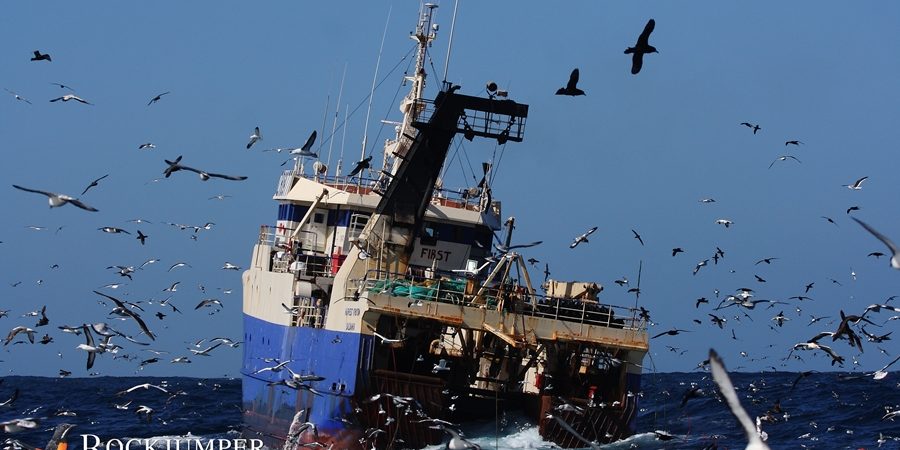
For me, the thought of pelagic birding evokes a sense of excitement that quickly takes over. The mystery behind the vast blue seas and its endangered birdlife bring a happy thought when there is an opportunity to go and experience it.
The word ‘Pelagic’ is derived from Greek, meaning “open seas,” and that is exactly what it is – endless swells, rolling eternally through the ocean. There is so much that we still need to learn about this non-terrestrial habitat, but one thing’s for sure: we need to protect its ever-increasingly endangered fauna.
Various Institutes have done some fantastic research and have been able to come up with essential information in protecting these nomadic species and agile fliers. One such example is the remarkable reduction in bird fatalities by fishing vessels, as they have implemented different techniques to stop seabirds from getting caught by hooks. One technique is known as the ‘Bird-scaring Line’, where an extra line with streamers attached is towed by the boat, deterring the birds from wanting to catch any fish behind the boat, which may be hooked. Another example is the eradication of certain introduced and invasive species like House Mice on Marion Island off the coast of South Africa – where many pelagic birds breed. Subsequent to their accidental introduction, the mice have started predating on seabird fledgelings, causing numerous fatalities which have obviously been detrimental to the seabird population. Some of these great conservation efforts have resulted in a positive growth trend for many species.
Wandering Albatross by Dušan Brinkhuizen
The fact that these birds are not usually seen on terra firma, unless one goes on an expedition to their breeding grounds on remote islands, makes them all the more fascinating. The vast blue oceans which we don’t often explore are their feeding grounds and to the typical birder, the chances of venturing out there don’t happen often. Some species are truly spectacular in their biology. For instance, the Wandering Albatross has the longest wingspan of any extant bird species in the world. Measuring up to a phenomenal 3.5 metres (11 feet) in length! It truly is a memorable sight to see this species glide about, skimming the tops of the swells with its long wings. Another is the Sooty Tern, which after fledging, doesn’t touch land until it reaches sexual maturity (up to 7 years); where it then comes ashore to breed.
Some of the most exciting pelagic birding trips can be experienced on numerous day trips throughout the world. Pelagic birding trips are usually conducted out of areas where nutrient-rich waters are found close to shore. Some of the more productive day trips are conducted in Australia, New Zealand, the west coast of the United States and the southern tip of South Africa. A longer expedition to Antarctica is definitely the ultimate pelagic trip, though – and would definitely be a highlight for anyone’s birding career .
Sooty Tern by Adam Riley
Birders who have done many pelagic trips will often tell you that it is by far the most exciting form of birding. The spectacle of witnessing thousands of seabirds whirling around your boat, looking for scraps of food, will no doubt remain an experience etched in your memory. The fact that these birds wander these endless waters make it all that more exciting, as you never know what to expect!
The excitement is riveting and palpable. Go and “Sea” for yourself!
Get Special Offers From Rockjumper Birding
Sign up now and get the best deals straight in your inbox!
- Phone This field is for validation purposes and should be left unchanged.
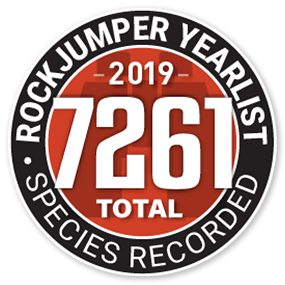
Modal title
Enquire about booking a tour.
- Tell us about your dream tour
- How many people do you expect to be on the tour? (optional)
- What are the date ranges you are looking at for this tour? (optional)
- How many days would you like the tour for? (optional)
- What is your price range for the tour? (optional)
Your Passport
Add Attachment
- About SOSSA
- Pelagic Trips Kiama
Pelagic Trips Southport
- Port Stephens Pelagic Trips
- Sydney Pelagic Trips
- Newsletters
- What's New?
- Advanced Search
Welcome to SOSSA
If this is your first visit, be sure to check out the FAQ by clicking the link above. You may have to register before you can post: click the register link above to proceed. To start viewing messages, select the forum that you want to visit from the selection below.
Registration to this forum is free! We do insist that you abide by the rules and policies detailed in the forum rules .
- SOSSA Projects
- 2015 Wollongong/Kiama
- 2014 Wollongong
- 2013 Wollongong
- 2012 Wollongong
- 2011 Wollongong
- 2010 Wollongong
- 2009 Wollongong
- 2008 Wollongong
- 2007 Wollongong
- 2006 Wollongong
- 2005 Wollongong
- 2004 Wollongong
- 2003 Wollongong
- 2002 Wollongong
- 2001 Wollongong
- 2000 Wollongong
- 1999 Wollongong
- 2017 Southport
- 2016 Southport
- 2015 Southport
- 2014 Southport
- 2013 Southport
- 2012 Southport
- 2010 Southport
- 2011 Southport
- 2009 Southport
- 2008 Southport
- 2007 Southport
- 2024 Port Stephens
- 2023 Port Stephens
- 2022 Port Stephens
- 2021 Port Stephens
- 2020 Port Stephens
- 2019 Port Stephens
- 2018 Port Stephens
- 2017 Port Stephens
- 2016 Port Stephens
- 2015 Port Stephens
- 2014 Port Stephens
- 2013 Port Stephens
- 2012 Port Stephens
- 2011 Port Stephens
- 2010 Port Stephens
- 2019 Sydney
- 2018 Sydney
- 2017 Sydney
- 2016 Sydney
- 2015 Sydney
- 2014 Sydney
- 2013 Sydney
- 2012 Sydney
- 2011 Sydney
- 2010 Sydney
- 2009 Sydney
- 2008 Sydney
- 2007 Sydney
- 2006 Sydney
- 2005 Sydney
- 2004 Sydney
- 2003 Sydney
- 2002 Sydney
- 2001 Sydney
- 2000 Sydney
- SOSSA Video
- Birds Australia Rarities Committee submissions
- NSW Ornithological Records Appraisal Committee submissions
Also STOP BIRDS DROWNING TROUGH SENTINEL SYSTEM
And Del's book www.mycountrylifethebook.com


Sunshine Coast Pelagic Bird Watching Tour, June 3, 2018
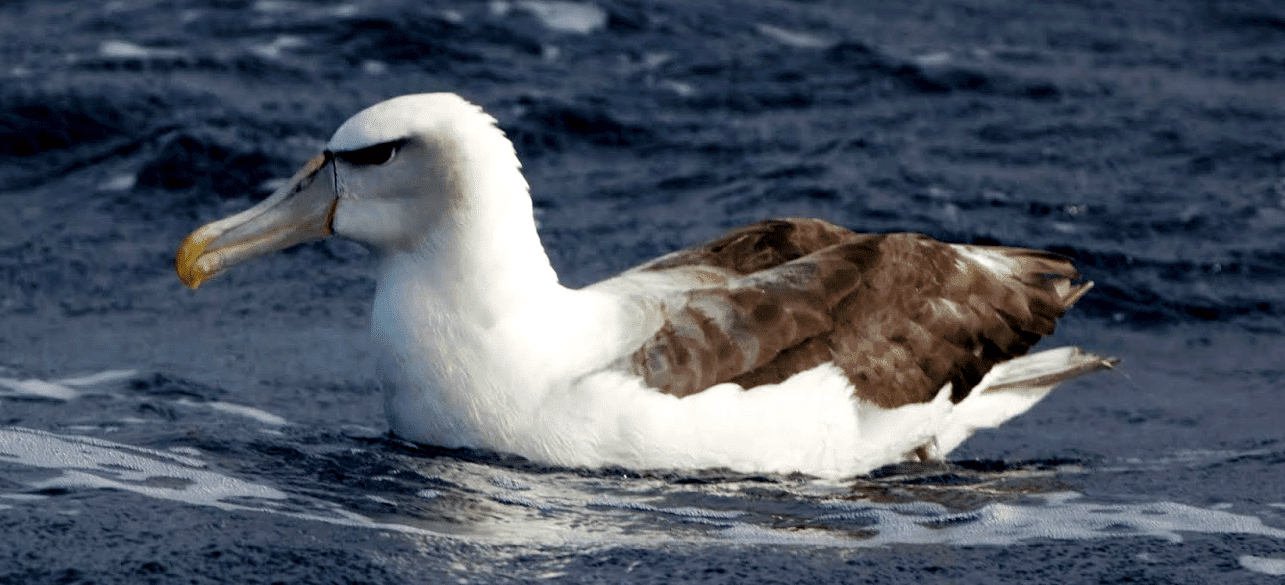
- June 5, 2018 May 29, 2021
- Jerry van Driel-Vis
- Bird Watching
On the way back we had a flock of Hutton’s Shearwaters with 2 Fluttering Shearwaters among them; the image here was the best I could manage of the latter. We arrived back at the marina at 4.05pm. Elist.
PARTICIPANTS:
Fluttering Shearwater 2 (2) Black-bellied Storm-Petrel 2 (1)
About Author
- Your Name *
- Email Address *
- Phone Number *
- Trip Type * Please confirm trip choice Fishing Charter Jet Boat Thrill Ride Guided Kayak Fishing Tour Cruise or Party Boat Hire Whale Watching Ashes Scattering Water Taxi Service
- 5 Hour (Half Day)
- 7 Hour (3/4 Day)
- 9 Hour (Full Day)
- 11 Hour (Mega Day)
- 12 Hour (Maxi Day)
- 18 Hour (Overnight Trip)
- Please describe charter
- Sunrise (available on all Charters)
- Midday (available on 5 and 7 Hr Charters only)
- Sunset (available on 5, 7, & 9 hour Charters only)
- 2 Hour Cruise or Party Boat trip
- 3 Hour Cruise or Party Boat trip
- Please describe trip
- 3 Hour trip on Crusader 1
- 2 Hour trip on Jet Boat
- Ideal Date * DD slash MM slash YYYY
- Number of People * Please enter a number from 1 to 23 .
- General Note
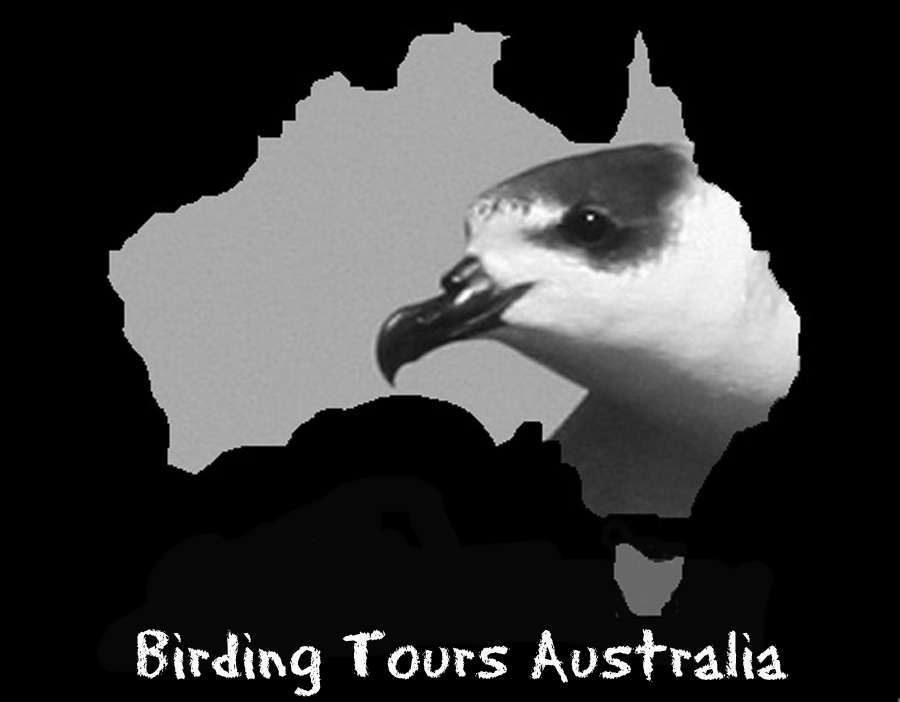
Torres Strait – Boigu, Saibai and Dauan
Islands of the northern torres strait – boigu, saibai and dauan.
The three Queensland islands of Boigu, Dauan and Saibai lie close to the Trans Fly area of New Guinea and are Australia’s two most northerly inhabited islands. Their close proximity to PNG means these islands are some of the most exciting birding locations in Australia. The islands are also amongst the remotest in Australia, access is difficult and there is very limited accommodation making visits for more than one day problematic.
These rarely visited islands contain some of Australia’s most sought after and highly prized birds such as:
- Red-capped Flowerpecker
- Singing Starling
- Collared Imperial-Pigeon
- Coconut Lorikeet
- Gurney’s Eagle
- Uniform Swiftlet
- Orange-fronted Fruit Dove
- Ashy-bellied White-eye
I n addition to these specialties we’ve seen Papuan Spine-tailed Swift, Zoe’s Imperial Pigeon, Orange-fronted Fruit Dove, Stephan’s Emerald Dove, Variable Goshawk, Hudsonian Whimbrel, Long-billed H/E, Garganey, House Swift, Pacific Swallow, Coroneted Fruit Dove and Long-tailed Honey-buzzard, Pink-spotted Fruit Dove and Blyth’s (Papuan) Hornbill.
Previous Trip Reports
The best time to visit these islands is like elsewhere, early morning and late afternoon. We anchor offshore in the lee of the island in our vessel Tropic Paradise and zodiac ashore each day. When not onshore we travel the protected coastline and rivers in search of the island’s specialties and PNG vagrants.
Our tours are held between January and April which is the peak time for birds moving between the islands and mainland PNG. Occasionally we’ll organise longer tours to visit other northern Torres Strait islands such as Dauan, Ugar and Darnley.
Prior to the tour there is accommodation on Horn Island which is the large island next to Thursday Island and home to the area’s main airport. Qantas fly twice daily to Horn Island from Cairns. The tours start when we board the airconditioned Tropic Paradise and conclude when we disembark. Once on board everything is supplied except alcohol, which we organise in the weeks prior to the tour.
Once you’ve met our skipper, crew and chef we depart Horn Island and travel a short distance to Little Tuesday Island for views of the range restricted Ashy-bellied (Pale) white-eye, before heading to the northern islands. Our itinerary on the northern islands is tide dependant and we could visit either Saibai or Boigu first.
Prior to departure we send out a trip bird list as well as ‘what to bring’ information. We do recommend having your Japanese Encephalitis vax prior to departure, although in recent years the advice is that it’s not essential.
Upcoming Tours
Our upcoming tours are in Feb/Mar 2026. Please see our ‘ Tours schedule ‘ page and contact us if you require any further information. Previous trip reports PDF’s are available to download.
Costs and Pricing
Tour Price From : 7 Days $5800pp AUD (Twin Share) 8 Days $6500pp AUD (Twin Share)
What we’ve seen
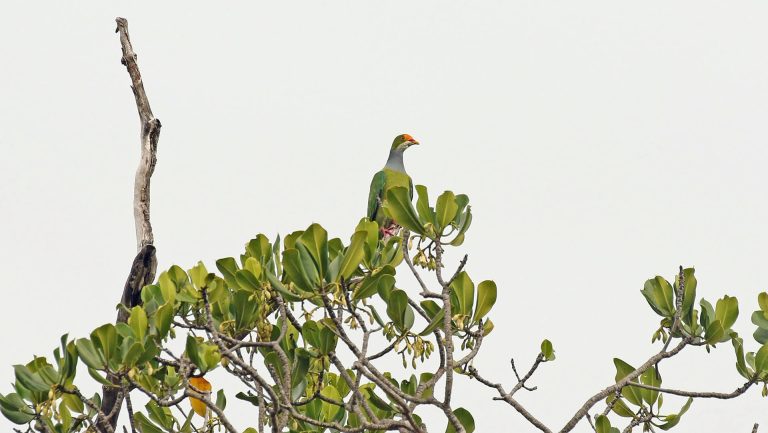
To date we have recorded:
Traversing the islands, anchoring offshore and travelling the island’s rivers and creeks, some of the species we’ve previously seen are:
- Collared Imperial Pigeon
- Red-capped (Papuan) Flowerpecker
- Gurney’s Eagle
- Blyth’s (Papuan) Hornbill
- House Swift
- Papuan Spine-tailed Swift
- Variable Goshawk
- Black-naped Tern
- Zoe’s Imperial Pigeon
- Great-billed Heron
- Eastern Yellow Wagtail
- Swinhoe’s Snipe
- Stephan’s Emerald Dove
- Pacific Swallow
- Coroneted Fruit Dove
- Long-tailed Buzzard
- Pink-spotted Fruit Dove
- Pinon’s Imperial-Pigeon

Port Fairy Pelagic Tour - Tour P1
Tour Cost: TBC per person (includes fuel surcharge) Number of Passengers: 21 Facilities: Proper toilet fitted. Accommodation: Additional to cost of tour. Port Fairy has plenty of accommodation. Check out accomondation websites or contact the local visitor information centre for more assistance on 1300 656 564 or 03 5568 2682. Meals: BYO Lunch. Morning tea available on board, please bring your own "keep cup". The group generally meets at one of the local restaurants for dinner on the night prior to tour (additional to cost of tour).
This full day tour can be run on a day to suit. From historical fishing village Port Fairy we head out to the continental shelf, approximately 30nm off shore where the sea floor drops away dramatically.
A pelagic tour is a great adventure and one of the only ways to see some of the world’s spectacular pelagic seabirds and marine mammals.
Touring off southern Australia gives you a wonderful chance of encountering up close and personal our spectacular albatrosses, shearwaters, petrels, storm petrels and more. It is a great opportunity to see dolphins, whales, seals and other marine creatures.
Potential Birds
Potential marine mammals.
As we are sailing off southern Australia tours may have to be cancelled or dates changed due to weather conditions.
Birding Tour Australia: from the Outback to the Wet Tropics
Go to: Australia Birding Tours | Birding Tours in Australasia | All our birding tours
Dates and Costs:
29 October – 15 November 2024
Spaces Available: 1
Price: AU$16,307 / $11,255 / £9,013 / €10,478 per person sharing (5-8 participants).
Single Supplement: AU$2,088 / $1,441 / £1,154 / €1,342
* Please note that currency conversion is calculated in real-time, therefore is subject to slight change. Please refer back to base price when making final payments.
29 October – 15 November 2025
Price: AU$16,500 / $11,388 / £9,120 / €10,602 per person sharing (5-8 participants).
Single Supplement: AU$2,297 / $1,586 / £1,269 / €1,476
29 October – 15 November 2026
Price: AU$17,530 / $12,099 / £9,689 / €11,264 per person sharing (5-8 participants).
Single Supplement: AU$2,525 / $1,743 / £1,395 / €1,622
Recommended Field Guide
(Please also read our blogs about recommended field guides for the seven continents here )
Tour Details
Duration : 18 days Group Size : 5 – 8 Tour Start : Melbourne, Victoria Tour End : Cairns, Queensland
Price includes:
All accommodation (as described above from Day 1 through Day 17) Meals (from lunch on Day 1 until breakfast on Day 18) Expert tour leader National park/birdwatching reserve/protected areas entrance fees Boat trips on the Daintree River and the Great Barrier Reef Private transportation during the tour
Price excludes:
International flights Airport transfers Domestic flights within Australia during tour (Required Melbourne-Brisbane and Brisbane-Cairns. We can book these for you and provide costs to ensure that everyone is on the same flight – estimate about AU$800) Any pre- or post-tour accommodation, meals, or birding/sightseeing/etc. excursions Visa if required Items of a personal nature, e.g. gifts, laundry, internet access, phone calls, etc. Any pre- or post-tour accommodation, meals, or birding/sightseeing/monument excursions Soft/alcoholic drinks (drinking water is safe from the taps, please bring a refillable water bottle) Personal travel insurance Gratuities (please see our tipping guidelines blog )
Eastern Australia : from the Outback to the Wet Tropics October 2024/2025/2026
Australia, the island continent, is a remote landmass that drifted away from Antarctica tens of millions of years ago. Without significant volcanic activity and other mountain-building forces it is also the flattest continent, with the world’s oldest soils. Despite its lack of topography this incredible landmass is one of extremes. The Outback, the continent’s core, is a vast and hostile desert with unpredictable weather patterns that sometimes flush the landscape green. Along the edges more regular precipitation allows ancient rainforests, heathlands, and fire-resistant sclerophyll woodlands to grow. Due to its long isolation and harsh environments Australia is now home to birds of a different feather, including eight endemic bird families and a further seven shared only with neighboring New Guinea. About 300 bird species are endemic to Australia, making it second only to Indonesia in this regard. Throughout this country’s every extreme its amazing avifauna has shown the adaptability and resiliency to survive in even the most challenging environments. In addition, this avifauna is just dripping with charismatic species, from bowerbirds to parrots to fairywrens to kookaburras to cassowaries to lyrebirds. Throughout the course of this small-group tour we sample habitats ranging from the arid plains north of Deniliquin to the wet rainforests of the Atherton Tablelands in search of as many of these wonderful birds as possible, while also appreciating the many other unique plants and animals along the way.
The incredible birds and wildlife of eastern Australia: a virtual birding tour by Andy Walker (who guides our Australian tours). This presentation was part of the highly recommended SE Arizona birding festival hosted by the Tucson Audubon Society (also see their YouTube channel here ).
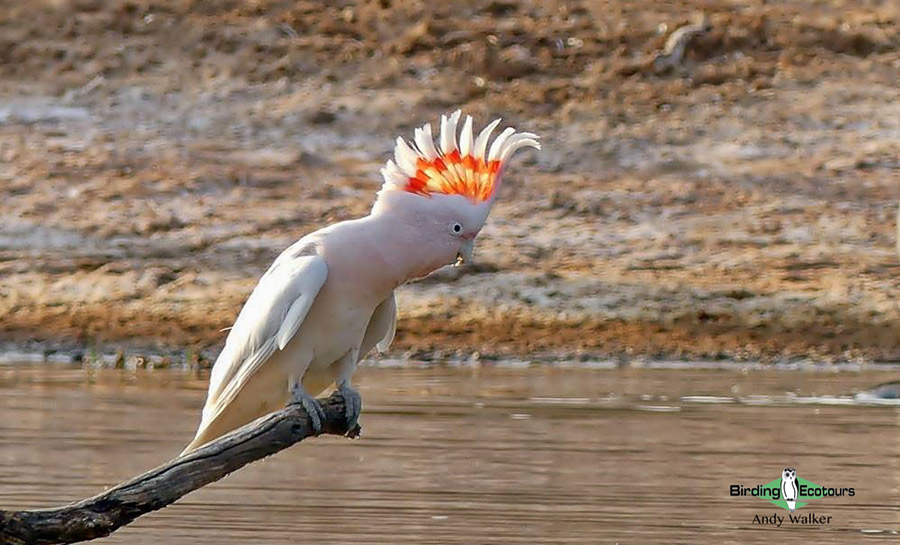
Our journey begins at the cosmopolitan city of Melbourne, Victoria in southeast Australia, visiting coastal heathland for several localized habitat specialists such as Gang-gang Cockatoo and Beautiful Firetail . Farther north and west towards the interior, arid mallee vegetation and saline lakes provide habitat for the mound-building Malleefowl , the impossibly blue Splendid Fairywren , the gorgeous Pink Cockatoo , among a host of other species. On one evening we make a special effort to observe the monotypic Plains-wanderer in the dry plains north of Deniliquin in New South Wales.
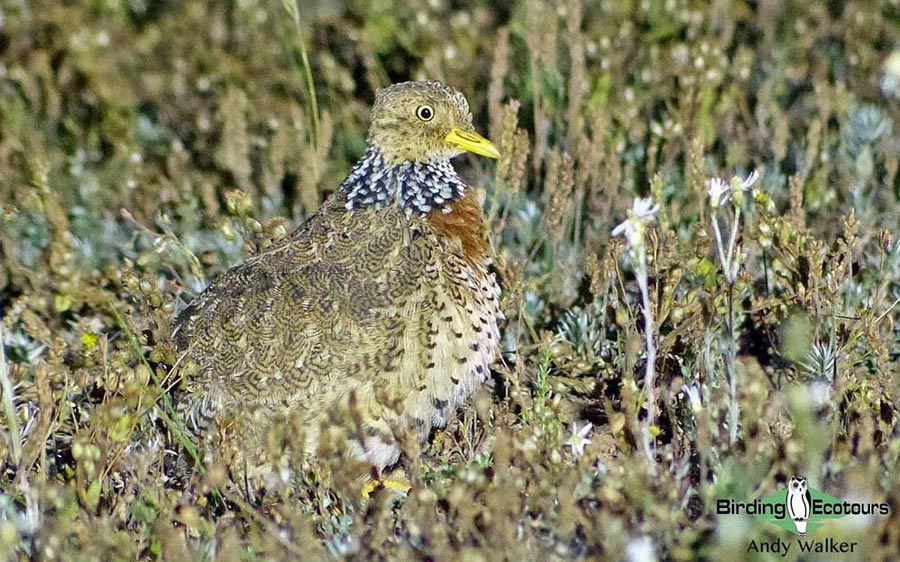
Following our time in New South Wales we will swing southeast through the sclerophyll forests of Chiltern and the temperate forests near Melbourne for targets such as Turquoise Parrot and Superb Lyrebird .
After an internal flight from Melbourne to Brisbane, Queensland, we drive up to the famous O’Reilly’s Rainforest Retreat, nestled within a large tract of subtropical rainforest, for a totally new set of stunning birds such as Paradise Riflebird , Regent Bowerbird , Satin Bowerbird , Noisy Pitta , Albert’s Lyrebird , and Australian Logrunner .
On the last leg of our journey we visit the Wet Tropics of far northern Queensland to explore one of the world’s most ancient rainforests for key species such as Southern Cassowary and Buff-breasted Paradise Kingfisher . We also take a day trip to the Great Barrier Reef, where the colors and diversity of the fish and corals rival those of the birds, with a chance to swim with Green Turtles . Evening spotlighting sessions on many of these nights should also produce a host of endearing and unusual nocturnal birds and mammals, which may include Papuan Frogmouth and Barking Owl . Other target birds in the north include Great-billed Heron , Australian Bustard , Victoria’s Riflebird , Tooth-billed Bowerbird , Great Bowerbird , Golden Bowerbird , Fernwren , and Chowchilla to name a few.
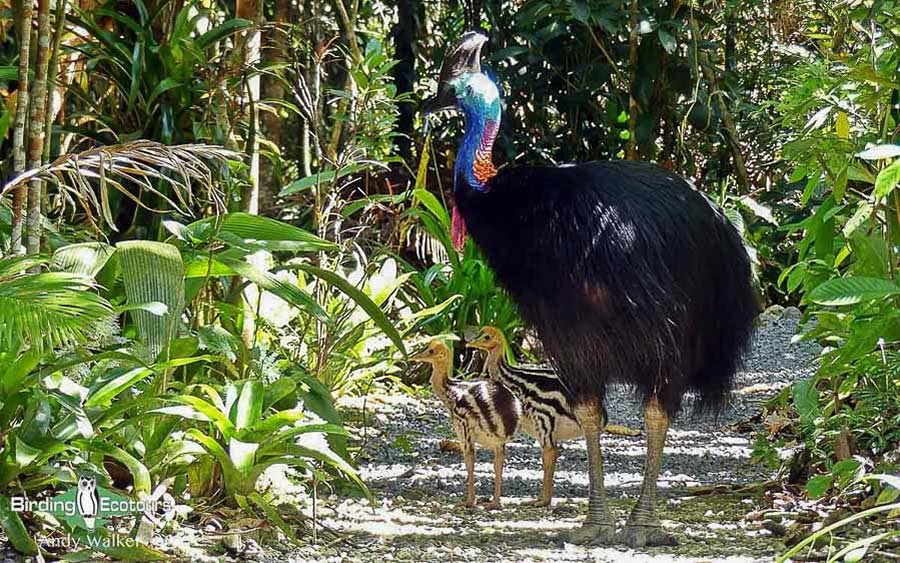
During our time in Australia, we will also look for some of the country’s incredible and unique animals, including Platypus , Short-beaked Echidna , Koala , Red Kangaroo , Eastern Grey Kangaroo , Common Ringtail Possum , Common Brushtail Possum , Musky Rat Kangaroo , and Common Wombat . The birds in Australia are incredible, but so are the mammals, reptiles, and amphibians that we will see; they combine to result in an awesome wildlife-filled experience. This continent is a naturalist’s dream!
Sometimes we do this tour in the reverse order shown in this itinerary. Please confirm the route for your tour with us before purchasing your flight tickets.
For those wishing to continue exploring Australia (and we fully recommend it), this tour can be combined with our Birding Tour Australia: Tasmania Bird Tour – Tasmanian Endemics and the Orange-bellied Parrot tour.
Itinerary (18 days/17 nights)
Day 1. arrival in melbourne.
Non-birding day with your arrival into Melbourne airport, the rest of the day will be at your leisure. We will meet in our hotel near the airport for an evening welcome dinner together.
Overnight: Melbourne Airport Hotel
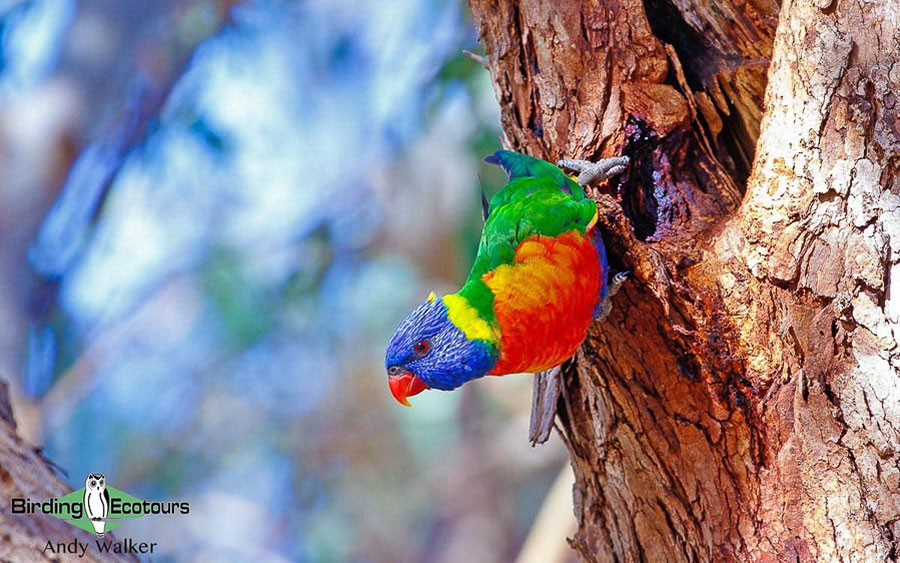
Day 2. Melbourne to Aireys Inlet
Over the course of the day we will enjoy some of Australia’s common and widespread, yet beautiful and interesting birds, such as Magpie-lark , Rainbow Lorikeet , Sulphur-crested Cockatoo , Willie Wagtail , Laughing Kookaburra , and Australian Magpie .
We will drive around Melbourne to the world-famous Werribee Western Treatment Plant area along the coast. Included in the Ramsar list of Wetlands of International Importance in 1983, this extremely rich, huge area contains a network of sewage treatment lagoons, unmodified saltmarsh, creeks, and lakes, which host large numbers of both sedentary and migratory waterbirds. We will navigate a series of roads around this area, where water levels permit. Among a wide assortment of other species Freckled Duck , Pink-eared Duck , and Musk Duck will be top priorities, as well as the secretive Australian Crake and the highly localized Striated Fieldwren . The area is often great for raptors, and we may find Black-shouldered Kite , Wedge-tailed Eagle , Australian Hobby , and Brown Falcon .
We then continue southward along the coast to Aireys Inlet for the night. Along the way a few stops may produce Southern Emu-wren , Black-tailed Nativehen , Black-fronted Dotterel , Cape Barren Goose , and White-winged Chough . Maybe we will even spot our first Eastern Grey Kangaroo along the way!
Overnight: Aireys Inlet
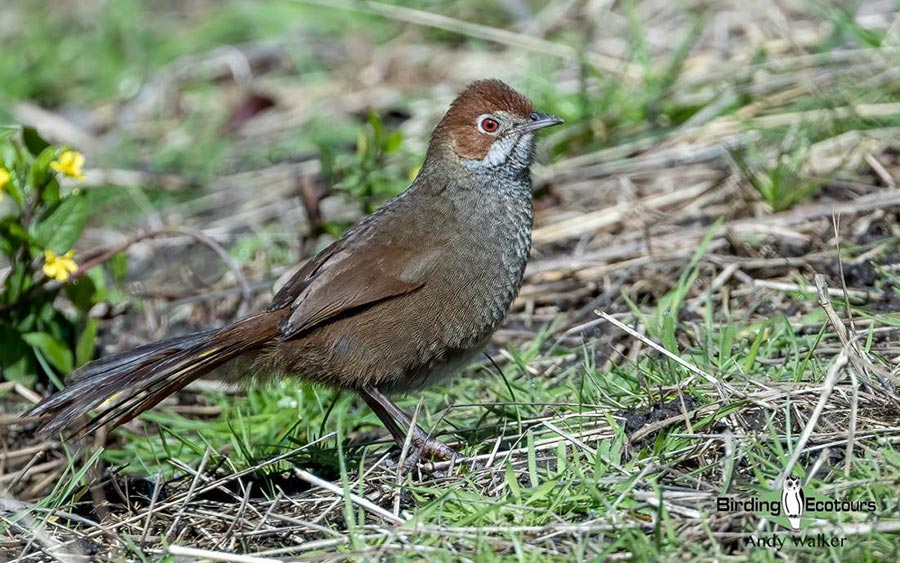
Day 3. Aireys Inlet to central Victoria
Composed of dense, low shrubs and scattered, twisted trees, coastal heathland occurs on impoverished soils with poor drainage. Despite the nutrient-poor soils, this habitat boasts a high diversity of plants as well as a unique community of birds that depend on them. We spend most of the morning exploring the scenic coastal heathlands of southwest Victoria, seeking out some of these species, such as Southern Emu-wren , Beautiful Firetail , and Rufous Bristlebird . Areas of taller vegetation may host the endearing Gang-gang Cockatoo , while a sea watch may yield Black-browed Albatross , Australasian Gannet , and other pelagic birds offshore.
As the day progresses, we drive inland into central Victoria for our first taste of box-ironbark forest, a habitat endemic to Australia. Because the component tree species in this habitat are such prolific flower and nectar producers, there is a correspondingly high diversity of nectar-feeding honeyeaters and lorikeets, including the normally scarce and local Purple-gaped Honeyeater , White-fronted Honeyeater , and Purple-crowned Lorikeet .
Overnight: Inglewood
Day 4. Central Victoria to Ouyen
After some brief morning birding around Inglewood we continue to the Ouyen area in northwestern Victoria. Along the way we will stop at Lake Tyrrell, a salt-crusted and mostly dry lakebed surrounded by saltbush and samphire. Despite its unlikely appearance this low vegetation is home to several charismatic birds, such as Orange Chat , White-winged Fairywren , and Eastern Bluebonnet , which we will target during our time here.
Founded in 1921, Wyperfeld National Park protects a significant tract of semi-arid mallee woodland and heathland. Depending on local conditions we may visit this site as we are passing. High on our list of priorities here would be the appropriately named Malleefowl , Southern Scrub Robin , Splendid Fairywren , and Southern Whiteface , and other birds of the dry Australian interior are also possible.
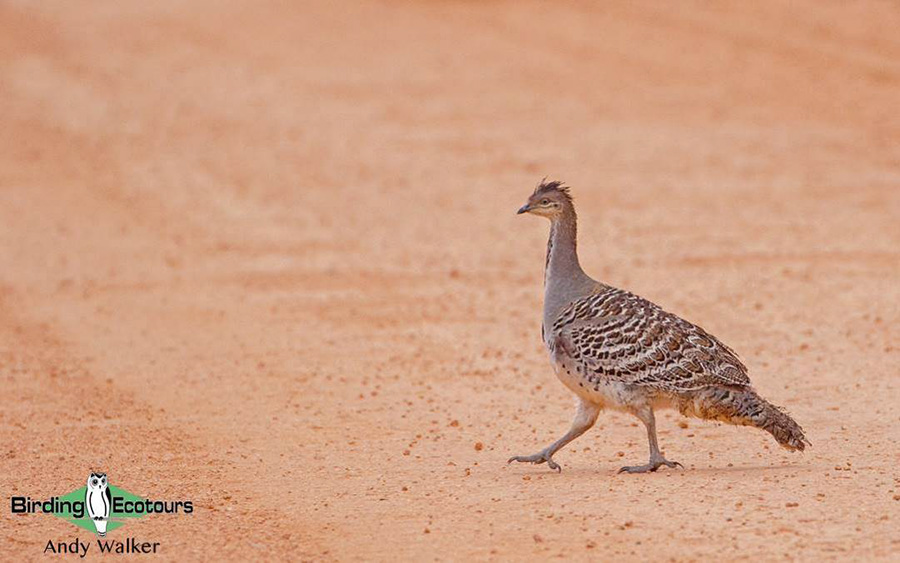
In the late afternoon we will arrive in Ouyen in the mallee habitat. Due to the number of secretive and highly sought birds here we will spend two nights and days birding the area, giving us plenty of time to try and connect with some of the arid area’s great birds like Malleefowl , notable for incubating its eggs in large nesting mounds.
Overnight: Ouyen
Day 5. Birding Hattah-Kulkyne National Park
As one of Australia’s largest and most pristine mallee reserves, Hattah-Kulkyne National Park boasts a wide variety of bird species that are much more difficult to see elsewhere, such as Mallee Emu-wren and Striated Grasswren . We will spend the full day birding within and around the park and town. In addition to the species mentioned above we will be looking for one of the most spectacular parrots in all of Australia, Pink Cockatoo . Hopefully the cockatoo will be accompanied by a rich and colorful supporting cast of dry-country specialties, such as Regent Parrot , Mulga Parrot , Crested Bellbird , and Emu . Possibly we will have our first look at the huge Red Kangaroo here too.
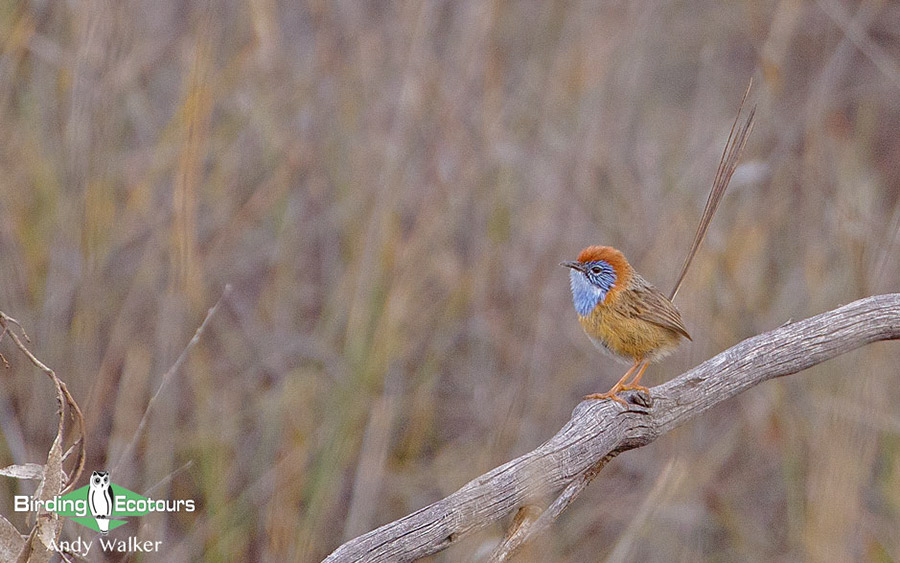
Day 6. Hattah-Kulkyne National Park, travel to Deniliquin, and Plains-wanderer night trip
We will have another morning birding in the wonderful Hattah-Kulkyne National Park, where we will continue to seek out the area’s specialties, maybe including White-winged Chough , Apostlebird , Chestnut Quail-thrush , and many more. As the morning progresses, we will head out of Victoria into neighboring New South Wales. We will likely stop at Lake Tutchewop along the way, which, depending on water levels, may hold the elegant Red-necked Avocet and the dapper Banded Stilt .
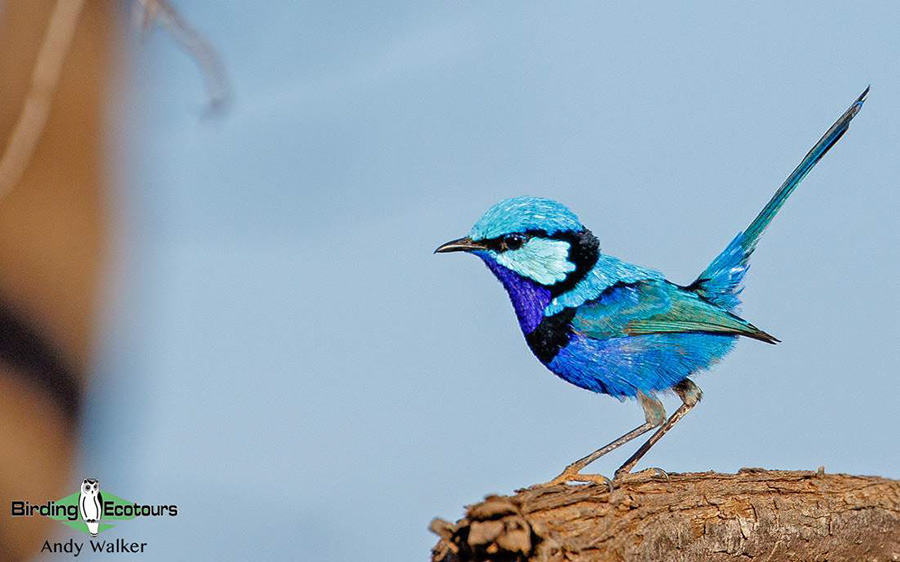
We will have a long day today, because during the evening we will go out to search for the bizarre Plains-wanderer , the sole representative of an endemic Australian family, most closely related to the shorebirds (but its closest living relatives are thought to be the seedsnipes of South America!). Although this species is the star attraction of this site, we may also encounter other birds, such as Inland Dotterel , Banded Lapwing , Stubble Quail , Little Buttonquail , Eastern Barn Owl , or Australian Owlet-nightjar on this nocturnal foray.
Overnight: Deniliquin
Day 7. Transfer to Wangaratta via Gulpa Island
After a late night we allow ourselves to sleep in before continuing our journey to Wangaratta via Gulpa Island and various other sites in the Riverina bioregion. Targets on this more laid-back day include the vivid Superb Parrot , the elusive Gilbert’s Whistler , and the striking White-backed Swallow as we aim to arrive in Wangaratta in the midafternoon. We will start looking for some of the birds listed for Day 8 if time permits.
Overnight: Wangaratta
Day 8. Wangaratta to Healesville
We will spend the morning birding in the beautiful woodland around the Warby-Ovens National Park which protects what is arguably the best flora and fauna assemblage of box-ironbark forest and woodland in Australia and forms an important link between the foothills of the Australian Alps with the plains of the Murray River. The trees which define this habitat produce an abundance of nectar when flowering, attracting birds from far and wide. The sounds of birds can be almost deafening during these times! Targets attracted to these blooms include Little Lorikeet , Black-chinned Honeyeater , and Painted Honeyeater . Elsewhere in the forest we search for the rainbow-like Turquoise Parrot , the bark-peeling Eastern Shriketit , the ground-dwelling Speckled Warbler , and more. We may even come across the unusual Short-beaked Echidna here.
After lunch we continue our journey southward to the town of Healesville near the city of Melbourne for the night. Here we will have a chance for some evening spotlighting for birds such as Greater Sooty Owl and mammals, possibly possums and gliders.
Overnight: Healesville
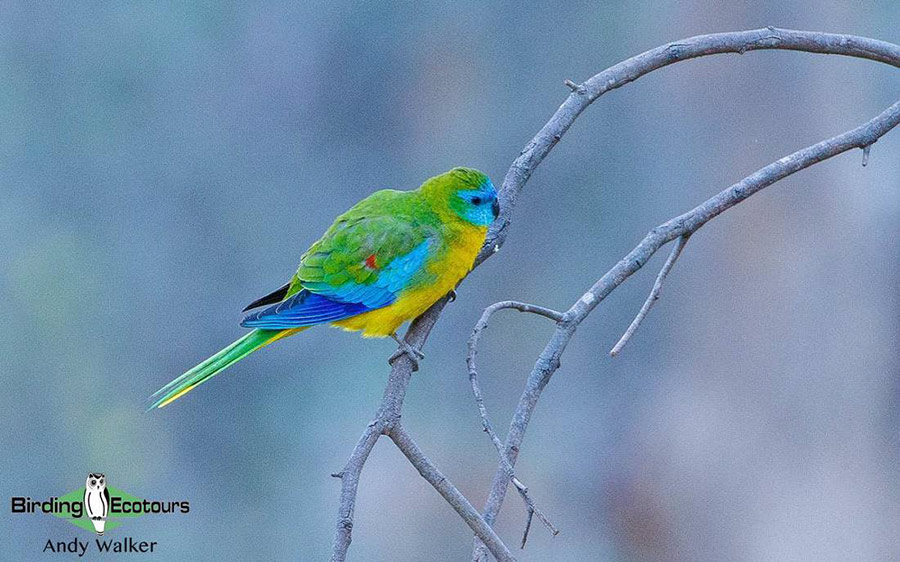
Day 9. Birding near Melbourne and conclusion of the “Outback” part of the tour
We spend most of the day at Bunyip State Park, about 40 miles (60 kilometers) east of Melbourne, birding wet sclerophyll forest and swampy heathlands. Within these mossy forests we hope to find several of Australia’s most charismatic and emblematic birds. Superb Lyrebird , an unrivalled mimic and the world’s largest songbird, will be chief among our targets. The forest and heathland communities are also home to Yellow-tailed Black Cockatoo , Pilotbird , Olive Whistler , Eastern Whipbird , Flame Robin , Rose Robin , Pink Robin , Red-browed Treecreeper , Australian Rufous Fantail , and more. It is sure to be a wonderful end to the birding on this part of the tour. We will continue back to Melbourne, thus completing our circuit of Victoria, where we will spend the night in an airport hotel ahead of an early flight the next day.
Overnight: Melbourne
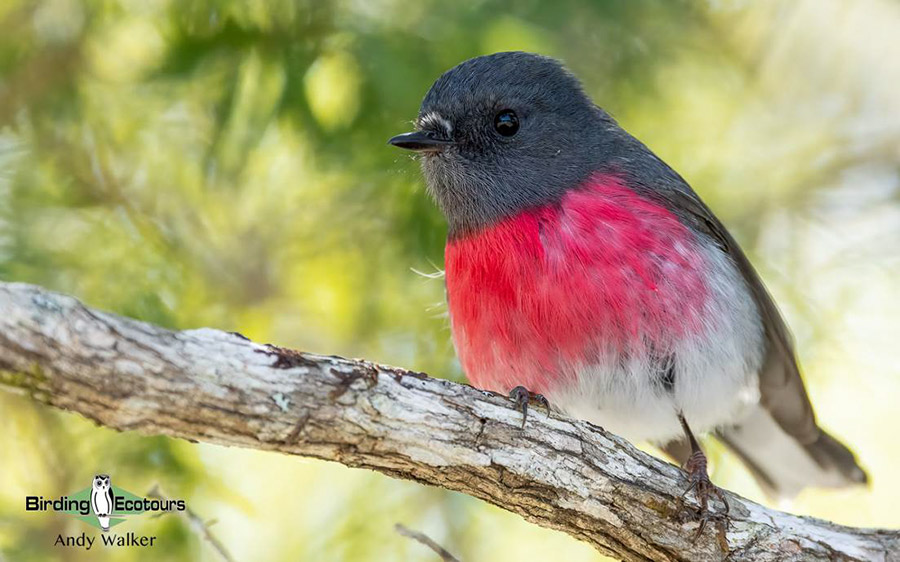
Day 10. Transfer from Melbourne to Brisbane and to Lamington National Park
After an early morning flight we arrive in Brisbane, the state capital of Queensland, to continue our tour. We first stop at a few mangrove sites near the airport itself, searching for the endemic Mangrove Honeyeater and Mangrove Gerygone . Nearby wetland sites often hold the elusive Spotless Crake , and we could obtain our first sightings of Comb-crested Jacana , Red-backed Fairywren , Torresian Kingfisher , and more while we search for them.
Afterwards we drive to the world-famous O’Reilly’s Rainforest Retreat at Lamington National Park. A colorful and interesting suite of birds attends the lodge gardens here, including Crimson Rosella , Australian King Parrot , Regent Bowerbird , Satin Bowerbird , Australian Brushturkey , and Wonga Pigeon . These birds are unusually tame and provide excellent opportunities for photography and our time here is always a major tour highlight.
Overnight: Lamington National Park
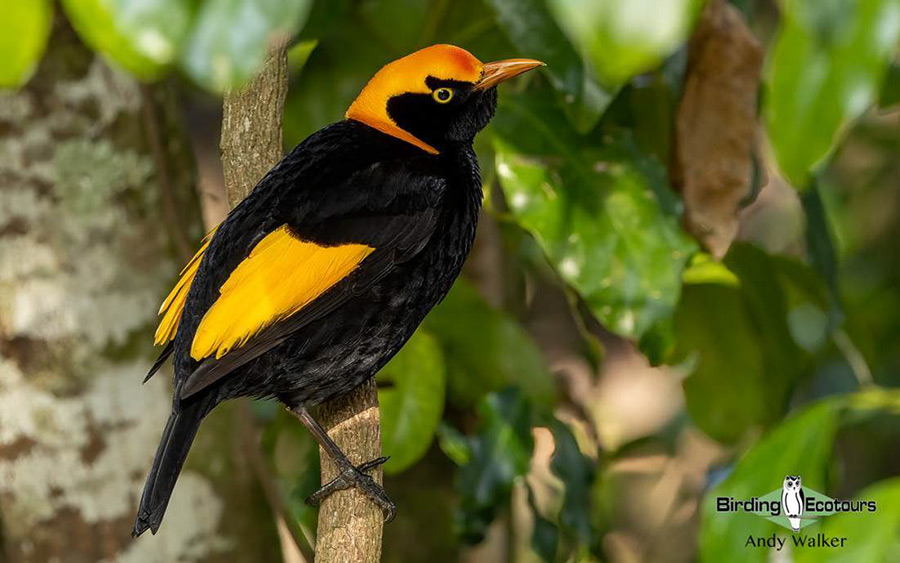
Day 11. Full day birding Lamington National Park
Situated in the heart of Lamington National Park, O’Reilly’s Rainforest Retreat is well-known for its rainforest location, diverse wildlife, and interesting history. Using the lodge as our base we spend the full day exploring the verdant network of subtropical rainforest trails in search of several spectacular birds unique to the area. Albert’s Lyrebird , Australian Logrunner , and Noisy Pitta inhabit the forest understory, while birds in the mid-story and canopy include Paradise Riflebird , Topknot Pigeon , Black-faced Monarch , and Green Catbird . We will make a concerted effort to see all of these species during our stay as well as leaving time to enjoy the site’s good variety of mammals, a good number of which only come out at night.
Day 12. Transfer from Brisbane to Cairns, birding the Cairns Esplanade
We will have a pre-breakfast birding walk into the forest near our accommodation once again, where we will keep searching for new and interesting species, maybe finding a cryptically plumaged Bassian and Russet-tailed Thrushes or the gorgeous and rather cute Rose Robin . After another sumptuous O’Reilly’s breakfast, we drive off the mountain and head back toward the city in time to make our flight farther north on our tour of the Australian east coast.
When we arrive in Cairns, depending on the tide time, we might make the short jaunt from our hotel to the Cairns Esplanade to enjoy its variety of shorebirds, from the hulking Far Eastern Curlew to the dainty Terek Sandpiper . We are sure to see plenty of Torresian Imperial Pigeons , Australasian Figbirds , and Metallic Starlings flying around near our accommodation.
Overnight: Cairns
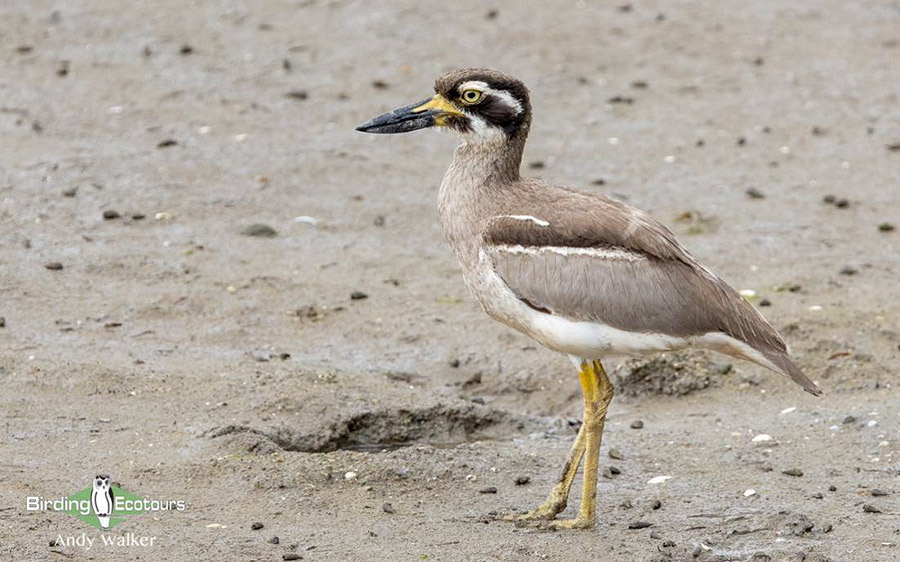
Day 13. Cairns birding and travel to Mission Beach
We will spend the morning birding at sites around Cairns, and may include visits to the Cairns Esplanade, Cairns Botanical Garden, and Cairns Centenary Lakes. We may also visit some sites a little further out of town, time permitting. A large list of species is possible featuring a wide range of birds. If the tidal situation is right, we can expect a lot of shorebirds, likely to include Great Knot , Curlew Sandpiper , Grey-tailed Tattler , and with luck, Beach Stone-curlew . In and around the trees along Cairns Esplanade, we may find Nankeen Night Heron , Bush Stone-curlew , Double-eyed Fig Parrot , Varied Honeyeater , Yellow Honeyeater , and Hornbill Friarbird . Forested areas here may hold Orange-footed Scrubfowl , Australian Brushturkey , Brush Cuckoo , and Grey Goshawk .
After lunch we will commence our journey south towards Mission Beach. We will likely make a stop at Etty Bay along the way. Our main target in this area is the humongous and rare Southern Cassowary , the largest bird in Australia by weight.
Overnight: Mission Beach
Day 14. Birding near Mission Beach, travel to Lake Eacham
We will spend some time in the morning looking for Southern Cassowary . There are often other great birds to be found around Mission Beach, and we will try to locate these during the morning before departing and heading up into the Atherton Tablelands. Some other birds we might find while looking for the ancient dinosaur-like bird, might include Australian Swiftlet , Fairy Gerygone , Yellow-spotted Honeyeater , Spectacled Monarch , Black Butcherbird , Green Oriole , and Dusky Myzomela .
We will have a long day today, because during the evening we will go out to search for the bizarre Plains-wanderer , the sole representative of an endemic Australian family, most closely related to the shorebirds (but its closest living relatives are thought to be the seedsnipes of South America!). Although this species is the star attraction of this site, we may also encounter other birds, such as Inland Dotterel , Banded Lapwing , Stubble Quail , Eastern Barn Owl , or Australian Owlet-nightjar on this nocturnal foray.
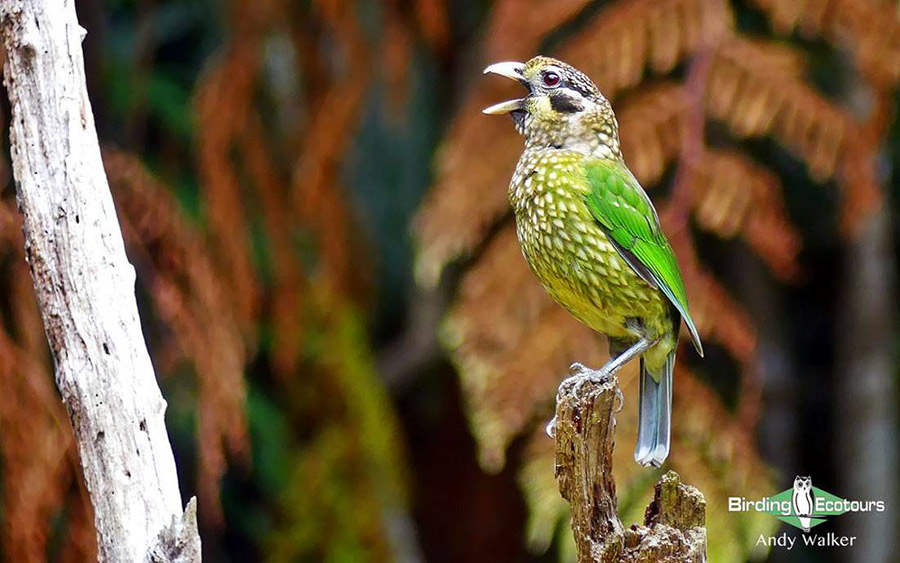
By mid-morning it will be time to leave the coast behind. We will spend the course of the next two days visiting a variety of sites on the Atherton Tablelands, a fertile plateau hosting several habitats from high altitude rainforest to drier eucalypt woodland. Although we will keep our itinerary flexible, based on our growing trip list, we will likely spend time birding the cooler wet forest of Mount Hypipamee National Park, Lake Barrine, and the Curtain Fig Tree for species including Tooth-billed Bowerbird , Golden Bowerbird , Wompoo Fruit Dove , Grey-headed Robin , Chowchilla , and more. We can, with some luck, also find Victoria’s Riflebird and Spotted Catbird in the gardens of our accommodation at Lake Eacham, a wonderful spot itself.
Nocturnal activity is also often exciting here, and we will be sure to spend some time looking for a range of possums, gliders, and more, as well as for the diurnal Musky Rat Kangaroo . Here we will also have a search for the bizarre Platypus and unusual (and rather rare) Lumholtz’s Tree Kangaroo .
Overnight: Lake Eacham
Day 15. Birding in the Atherton Tablelands
The early morning activity around our accommodation is usually a wonderful experience and we will look for, and listen to Spotted Catbird , Victoria’s Riflebird , Yellow-breasted Boatbill , Australian Golden Whistler , Grey-headed Robin , Superb Fruit Dove , Wompoo Fruit Dove , Brown Cuckoo-Dove , Macleay’s Honeyeater , Scarlet Myzomela , and Forest Kingfisher .
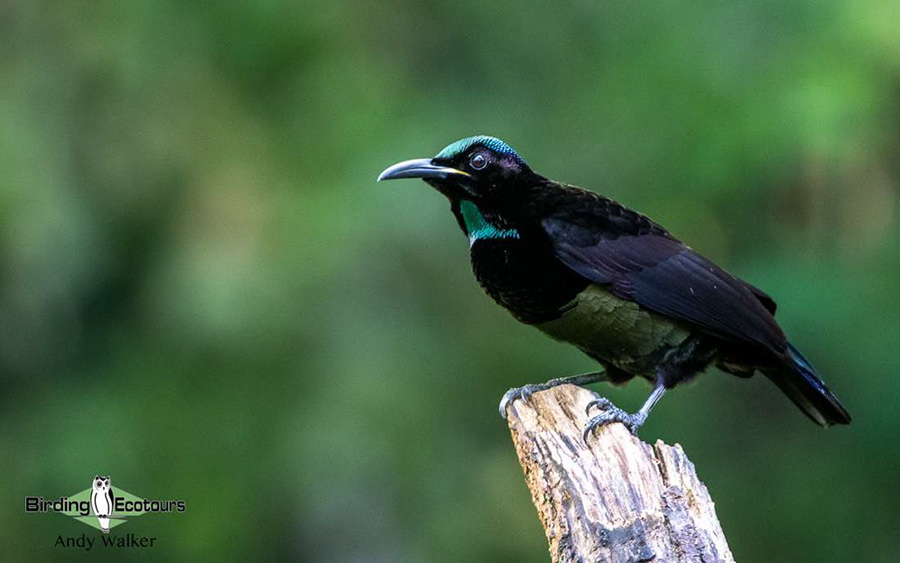
During the day we will visit the wetter higher elevations of the Atherton Tablelands, possibly trying to locate the shy Chowchilla and other targets like Atherton Scrubwren , Mountain Thornbill , Tooth-billed Bowerbird and Golden Bowerbird . We will also look for any wetland sites that might support Magpie Goose , Sarus Crane , Brolga , Wandering Whistling Duck , or Plumed Whistling Duck and potentially shorebirds and other waterfowl (depending on water levels here and in other parts of Australia).
In the afternoon we will make our way northward into the much drier part of the Atherton Tablelands, stopping at various sites, which may include Granite Gorge Nature Park and Mareeba town. There will be no shortage of potential targets, such as Australian Bustard , Squatter Pigeon , Red-winged Parrot , Red-tailed Black Cockatoo , Spotted Harrier , Blue-winged Kookaburra , Great Bowerbird , and Double-barred Finch . After a long day of birding, we will arrive at our accommodation.
Overnight: Mareeba
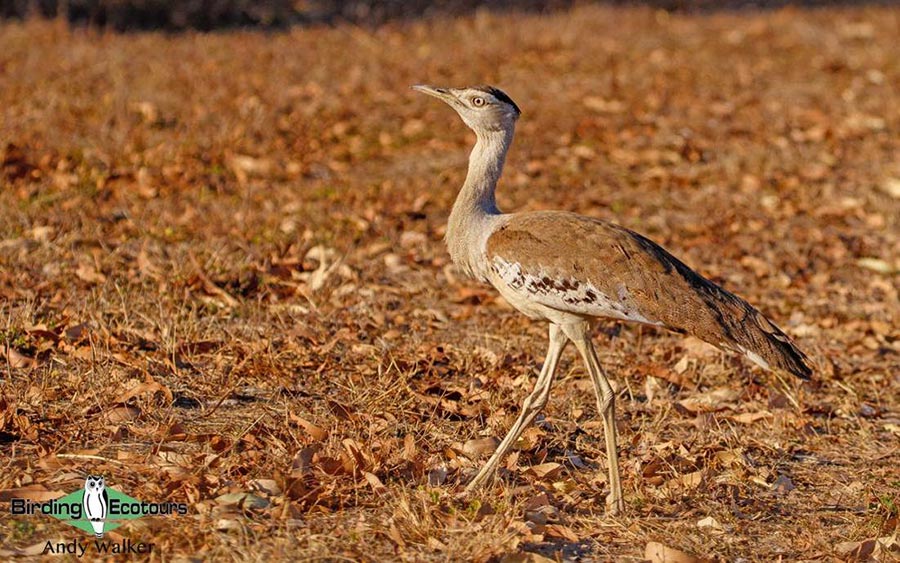
Day 16. Mareeba, Daintree River Cruise, and travel to Cairns
We will have a long day today. We will spend the early morning birding near to Mareeba and will make our way to the base of Mount Lewis. We will make a few stops along the way, for species such as Yellow-bellied Flyrobin and White-browed Robin . At the base of Mount Lewis, we will look for Lovely Fairywren , Superb Fruit Dove , Northern Fantail , and Buff-breasted Paradise Kingfisher .
In the afternoon we will start the journey down to the Daintree River, where we will have a late-afternoon boat cruise. By scanning the sandy banks and lush riverside vegetation from the comfort of our boat we will keep a sharp eye out for the bulky Great-billed Heron , family groups of Shining Flycatcher , the cryptically camouflaged Papuan Frogmouth , and flocks of the diminutive Double-eyed Fig Parrot – maybe even the rare Little Kingfisher .
We will stop for some dinner on our way back to Cairns, where we will arrive in the early evening and head to bed after what will have been a long and tiring, but bird-filled day.
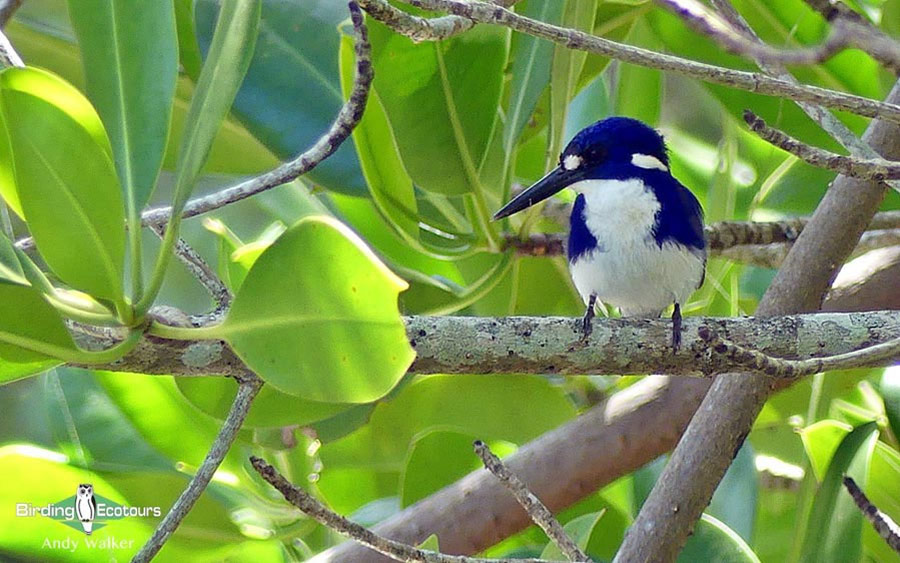
Day 17. Great Barrier Reef trip
We will spend the final full day of the tour on an enjoyable and relaxing boat trip to the Great Barrier Reef. The Great Barrier Reef is an ecosystem of many superlatives that no words can do justice. After an early breakfast we board a boat that will take us out to experience this incredible reef system. Our first stop is Michaelmas Cay, a tiny islet that hosts an impressive number of nesting seabirds. Sooty Tern , Brown Noddy , and Greater Crested Tern dominate, but Lesser Crested Tern , Black Noddy , and Black-naped Tern are also possible. Brown Booby and occasionally Red-footed Booby can be seen perched on man-made structures, while marauding Great and Lesser Frigatebirds often soar overhead. We will spend some time here enjoying the spectacle. Weather and sea conditions permitting, we should be able to land on the cay to get close-up views of these seabirds. There is also the likelihood of snorkeling here, but for this part of our reef trip the focus is really on the birds, though we will also keep our eyes peeled for dolphins and sea turtles.
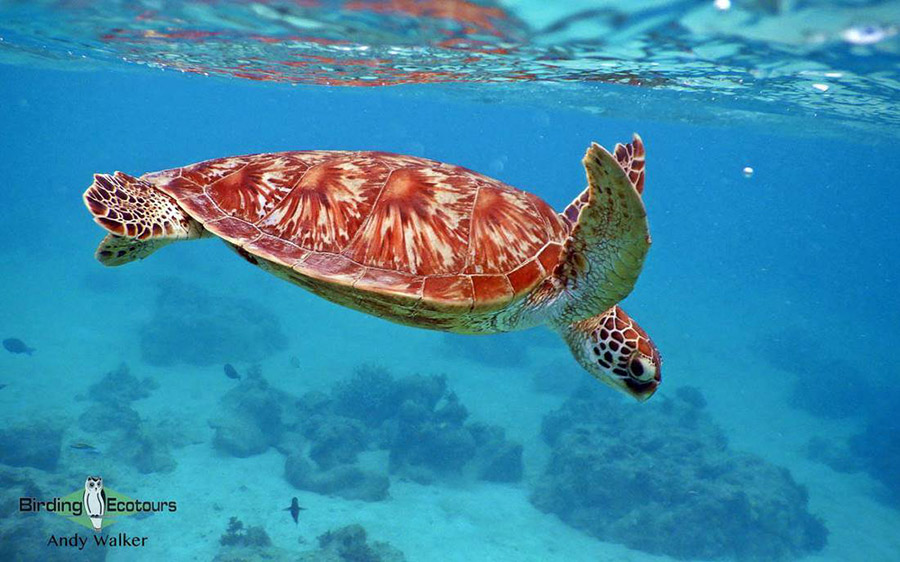
After lunch the boat usually moves across to Hastings Reef, where there will be an option to snorkel, scuba dive, or take a glass bottom boat tour, all three options giving a wonderful opportunity to observe the plethora of shockingly colorful life below the surface. When we return to shore in the middle of the afternoon we will amble back to our hotel, looking for any birds along the Cairns Esplanade as we go (tide dependent).
Day 18. Transfer to Cairns Airport , tour concludes
Non-birding day with your departure from Cairns Airport.
Overnight: Not included
Please note that the itinerary cannot be guaranteed as it is only a rough guide and can be changed (usually slightly) due to factors such as availability of accommodation, updated information on the state of accommodation, roads, or birding sites, the discretion of the guides and other factors. In addition, we sometimes have to use a different international guide from the one advertised due to tour scheduling.
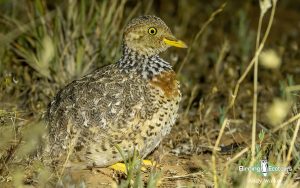
Plains-wanderer
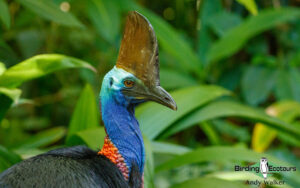
Southern Cassowary
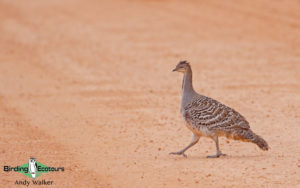
Pink Cockatoo
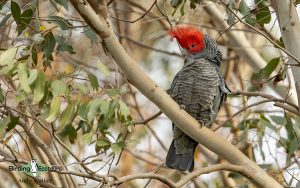
Gang-gang Cockatoo
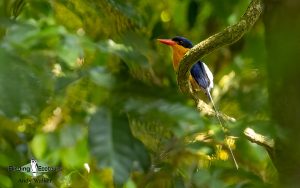
Buff-breasted Paradise Kingfisher
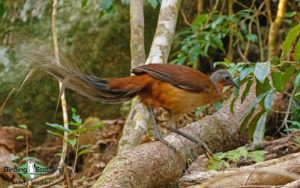
Albert's Lyrebird
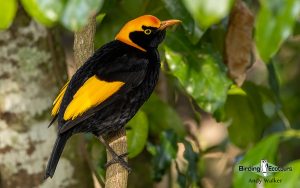

Regent Bowerbird
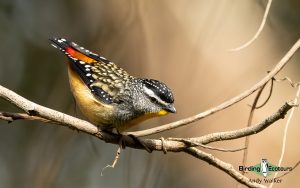
Spotted Pardalote
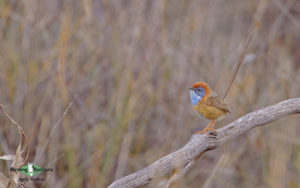
Mallee Emuwren
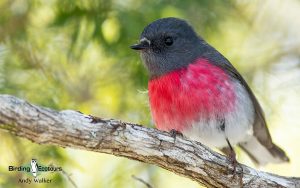
Diamond Firetail
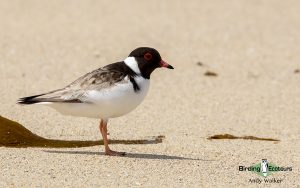
Hooded Plover
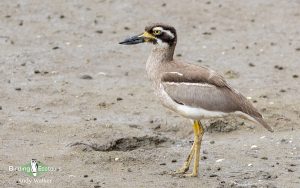
Beach Stone-curlew
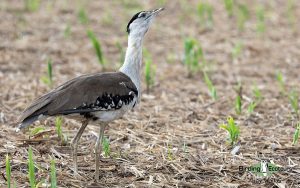
Australian Bustard
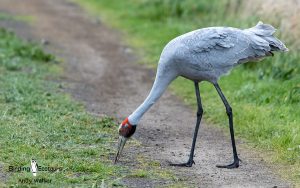
Victoria's Riflebird
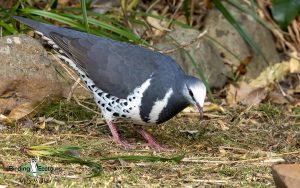
Wonga Pigeon
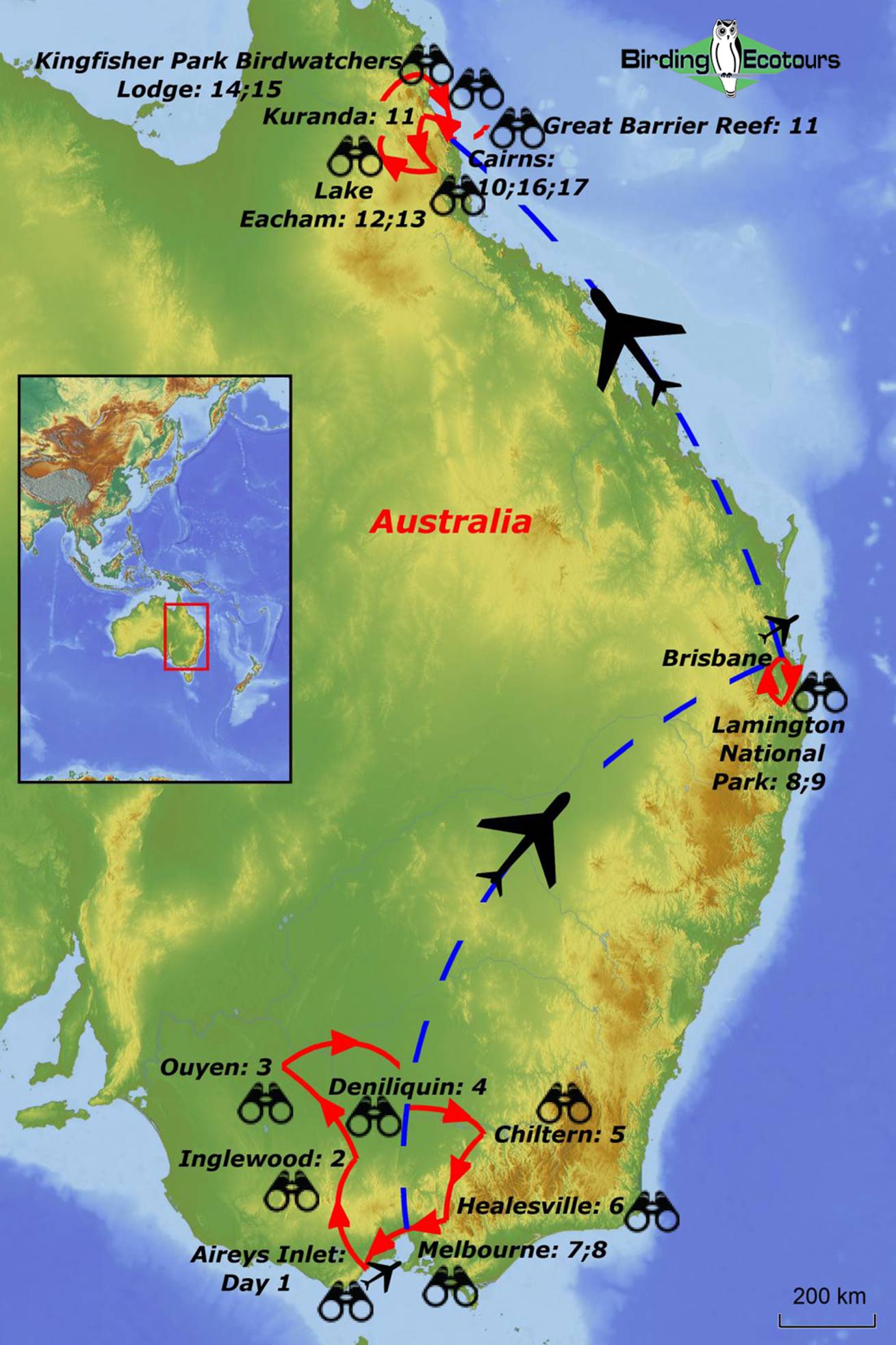
Eastern Australia: From the Outback to the Wet Tropics Trip Report, October 2023
30 october – 16 november 2023, by andy walker.
DOWNLOAD TRIP REPORT
This Eastern Australia birding tour started in Melbourne, Victoria on the 30 th of October 2023 and ended in Cairns, Queensland on the 16 th of November 2023. This Australian bird tour focused on Australian endemic birds and Australian endemic bird families found in Victoria (including a brief foray into New South Wales) and southern and northern Queensland.
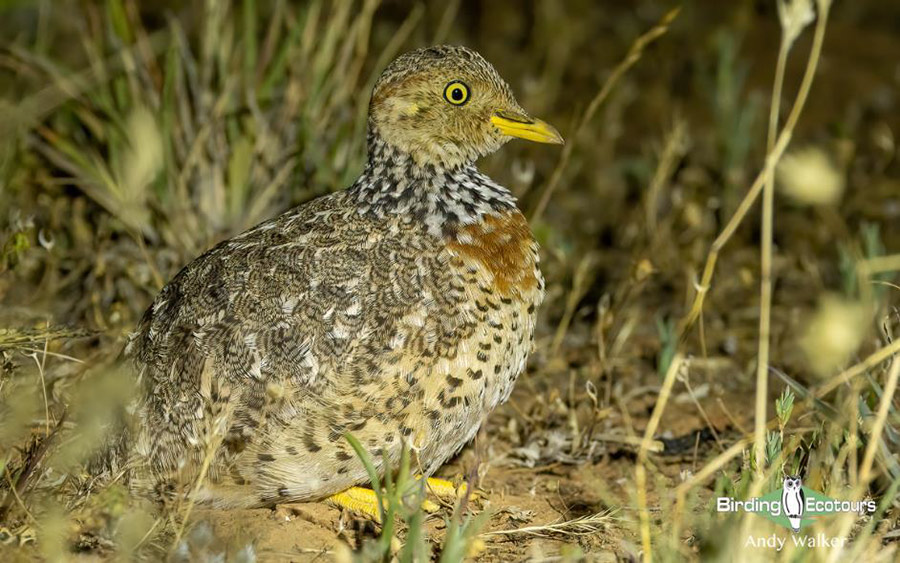
Plains-wanderer was a big target on our Eastern Australia birding tour and proved a massive highlight, with three birds seen well. They formed part of an incredible evening birding session early in the tour, which was a tour highlight in its own right.
We recorded 379 bird species on this Australian birdwatching tour (three of these were heard only). The list of highlight birds seen is very long and included some of the best birds in Australia, including Southern Cassowary , Emu , Magpie Goose , Malleefowl , Spotted Nightjar , Tawny Frogmouth , Sarus Crane , Brolga , Red-chested Buttonquail , Banded Stilt , Plains-wanderer , Black-necked Stork , Great-billed Heron , Wedge-tailed Eagle , Grey Goshawk , Greater Sooty Owl , Lesser Sooty Owl , Buff-breasted Paradise Kingfisher , Red-backed Kingfisher , Laughing Kookaburra , Blue-winged Kookaburra , Cockatiel , Glossy Black Cockatoo , Gang-gang Cockatoo , Pink Cockatoo , Superb Parrot , Budgerigar , Noisy Pitta , Albert’s Lyrebird , Superb Lyrebird , Green Catbird , Golden Bowerbird , Regent Bowerbird , Lovely Fairywren , Mallee Emu-wren , Painted Honeyeater , Macleay’s Honeyeater , Rufous Bristlebird , Australian Logrunner , Pied Monarch , Apostlebird , Paradise Riflebird , Victoria’s Riflebird , Flame Robin , Red-capped Robin , Bassian Thrush , and Diamond Firetail .
In addition to the great birds seen, we also found a nice selection of other animals, including 40 species of mammals, featuring highly sought species such as Koala , Platypus , Red Kangaroo , and Lumholtz’s Tree Kangaroo , 23 species of reptiles including Saltwater Crocodile and Boyd’s Forest Dragon , and numerous gorgeous butterflies, moths, dragonflies, and plants. Lists of birds and other plants and wildlife recorded during this Australian bird tour follow the report.
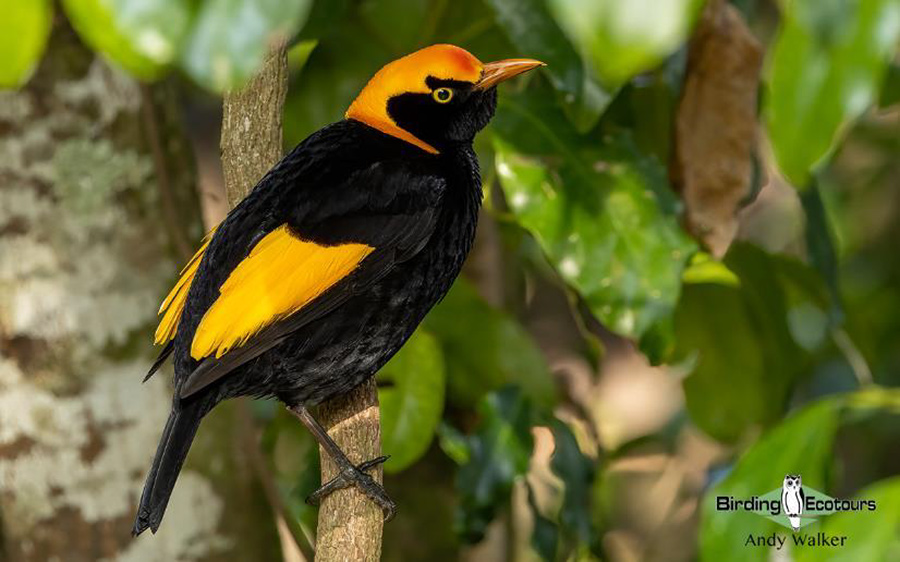
Regent Bowerbird showed well while we were birding at O’Reilly’s Rainforest Retreat.
Detailed Report
Day 1, 30 th october 2023. arrival in melbourne.
We arrived in Melbourne, Victoria in the late afternoon after completing our successful Tasmania bird tour , (trip report here ). We had a delicious group welcome meal in the evening, discussing the plans for the coming few weeks of birding in Victoria, New South Wales, and southern and northern Queensland, Australia. The excitement was building.
Day 2, 31 st October 2023. Birding Melbourne to Healesville
We headed through the northern suburbs of Melbourne, making a brief stop at a parkland, where we got some of the common Australian birds under our belt, with species such as Rainbow Lorikeet , Eastern Rosella , Australian Magpie , Pied Currawong , Grey Currawong , Noisy Miner , Red Wattlebird , Little Raven , and Magpie-lark all seen well, it was a great introduction.
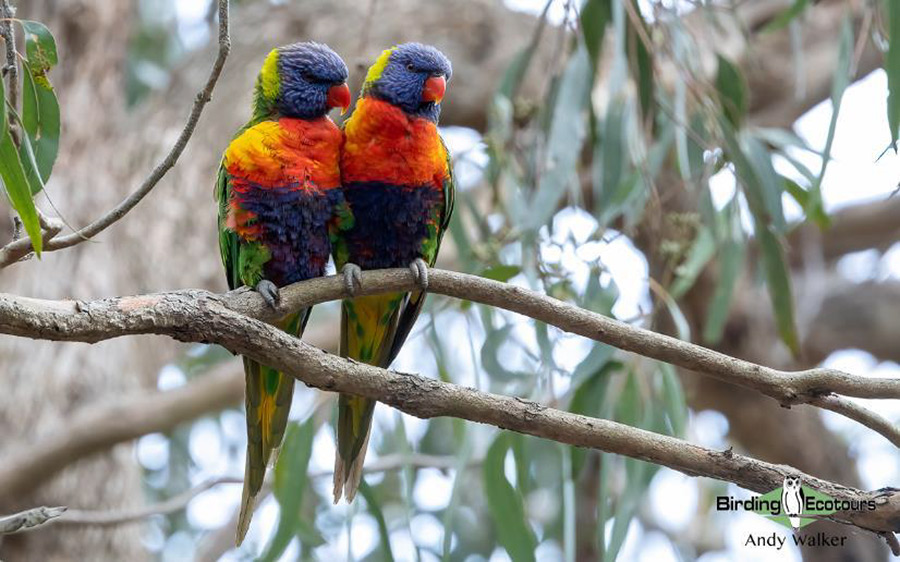
A pair of Rainbow Lorikeets were busy allopreening and allowed great views. A common but attractive bird in eastern areas of Australia and always a popular bird at the beginning of a tour.
Commencing our journey away from Melbourne city, we visited the beautiful Dandenong Ranges National Park , where we found our main target, the vocally magical Superb Lyrebird . While we were walking around the impressive and huge forest, we picked up many birds, including Crimson Rosella , Australian King Parrot , Sulphur-crested Cockatoo , Long-billed Corella , Australian Golden Whistler , Eastern Yellow Robin , Large-billed Scrubwren , White-browed Scrubwren , Grey Fantail , Eastern Spinebill , and White-throated Treecreeper .
After a wonderful lunch, we visited a wetland site, where we found Australasian Darter , Little Pied Cormorant , Little Black Cormorant , Australasian Grebe , Dusky Moorhen , Eurasian Coot , Australasian Swamphen , Pacific Black Duck , Chestnut Teal , Grey Teal , Maned Duck , Masked Lapwing , Galah , Little Corella , Shining Bronze Cuckoo , Little Wattlebird , and a pair of White-winged Trillers . We then moved across to a sandy hillside, where we found six beautiful orchid species, including Large Flying Duck Orchid , Eastern Mantis Orchid , and Purple Beard Orchid . After enjoying these great plants (and a few White-winged Choughs ), we continued our drive to our accommodation for the night in Healesville, picking up Black-shouldered Kite , Yellow-billed Spoonbill , and White-necked Heron along the way.
After a wonderful dinner at our lodge, featuring minor distractions from White-naped Honeyeater , Yellow-faced Honeyeater , and Eastern Spinebill , we went out for a rather enjoyable night walk. Top highlights from the walk included excellent looks at a Greater Sooty Owl , along with very good sightings of both Greater Glider and Yellow-bellied Glider . It had been some start to this Australian birding tour!
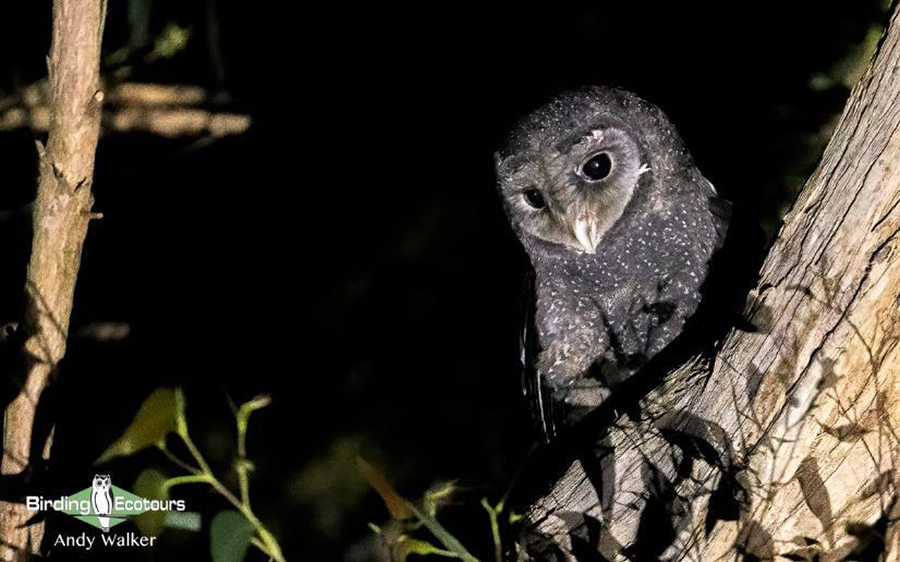
We enjoyed some excellent views of Greater Sooty Owl while out on a night walk.
Day 3, 1 st November 2023. Healesville to Chiltern
After breakfast we birded around our accommodation at Healesville, enjoying sightings of Gang-gang Cockatoo , Australian King Parrot , Crimson Rosella , and Spotted Pardalote . We then drove up into Toolangi State Forest, where we found Flame Robin , Rose Robin , Red-browed Treecreeper , Satin Flycatcher , and more Gang-gang Cockatoos .
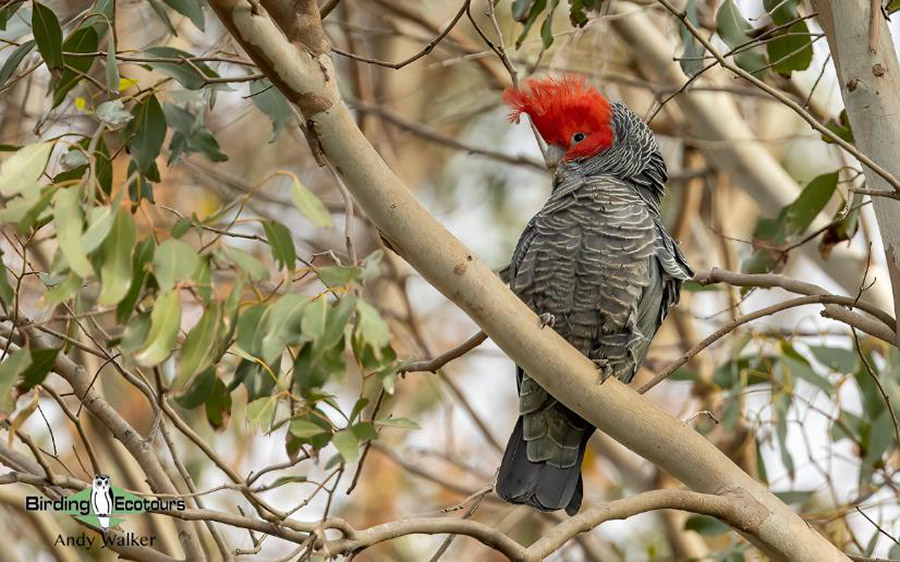
Several Gang-gang Cockatoos were present in a small woodland.
After warming ourselves up with a hot drink, we visited the wetlands near Yea , where we added plenty of new birds to our growing list. Some of the top highlights included Bell Miner , Striated Pardalote , Leaden Flycatcher , White-throated Gerygone , and Little Eagle . Driving north, we made our way to the Warby-Ovens National Park , a beautiful region. Here we had brief sightings of Turquoise Parrot , but also had great looks at Red-capped Robin , Hooded Robin , Leaden Flycatcher , Western Gerygone , Varied Sittella , Rufous Songlark , and Rufous Whistler .
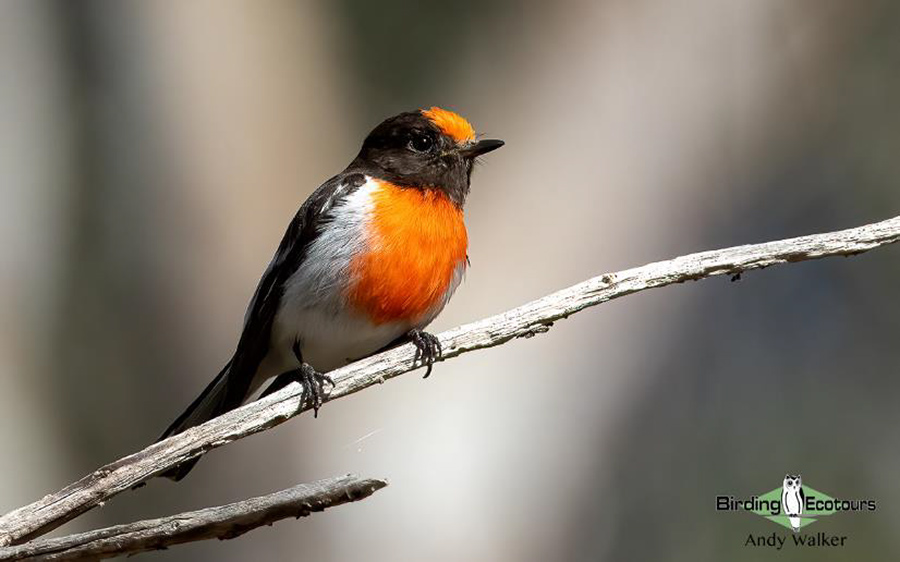
Red-capped Robin was also added to our rapidly growing Australasian Robins family list.
As we explored the area further, we found Crested Pigeon , Galah , Eastern Rosella , Sacred Kingfisher , Laughing Kookaburra , White-winged Triller , nesting Restless Flycatchers , Willie Wagtail , Grey Fantail , Wedge-tailed Eagle , Whistling Kite , Brown Falcon , Nankeen Kestrel , Dusky Woodswallow , and Diamond Firetail .
Day 4, 2 nd November 2023. Chiltern to Deniliquin
A very long day, but one of the most enjoyable of the whole tour. We spent the morning birding around Chiltern-Mt. Pilot National Park and Warby-Ovens National Park , and the birding was great. We had excellent views of Painted Buttonquail , Pallid Cuckoo , Sacred Kingfisher , Red-rumped Parrot , Olive-backed Oriole , White-throated Treecreeper , Brown Treecreeper , White-winged Chough , Yellow-tufted Honeyeater , Fuscous Honeyeater , Black-chinned Honeyeater , Speckled Warbler , Jacky Winter , and Rufous Songlark . We also spotted Eastern Grey Kangaroo and Swamp Wallaby .
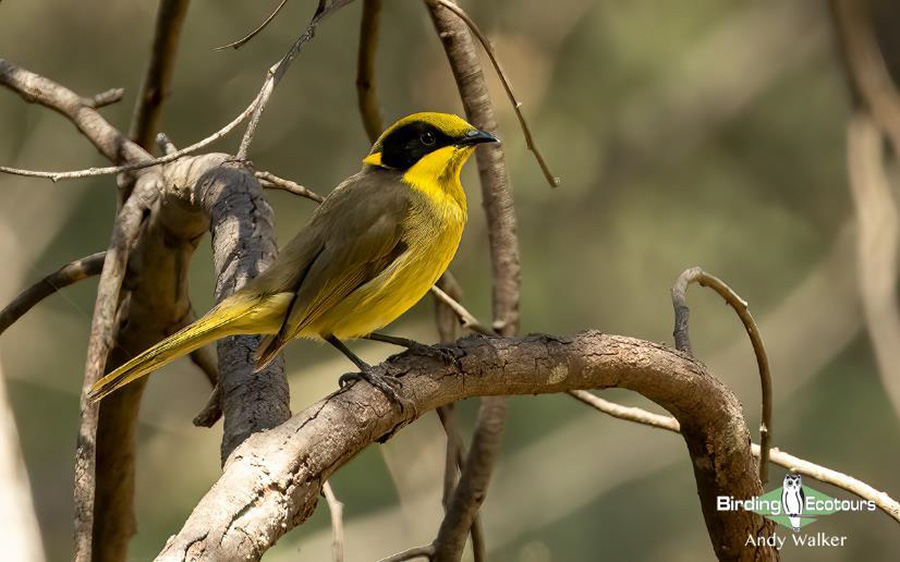
An attractive Yellow-tufted Honeyeater from Chiltern-Mt. Pilot National Park.
After lunch we took a look at the mighty Murray River, here we found Nankeen Night Heron , Whistling Kite , Crimson (Yellow) Rosella , Noisy Friarbird , and Little Friarbird . We then completed our drive from Victoria to Deniliquin, New South Wales.
Our late afternoon and evening birding was simply sensational. We stopped at some bushland that was featuring lots of flowering plants, just north of Deniliquin, where we found Australian Owlet-nightjar , Horsfield’s Bronze Cuckoo , Black-shouldered Kite , Black Kite , Rainbow Bee-eater , Greater Bluebonnet , Black Honeyeater , Singing Honeyeater , Striped Honeyeater , Spiny-cheeked Honeyeater , Pied Butcherbird , Australian Raven , and Mistletoebird . Driving north we picked up our first family group of Emus and shortly after had close perched views of a pair of Wedge-tailed Eagles , with other species seen including Black-tailed Nativehen , Australian Crake , Red-kneed Dotterel , White-winged Fairywren , Singing (Horsfield’s) Bush Lark , Fairy Martin , Brown Songlark , and Australian Pipit .
After our picnic dinner it was time for the main event, our night birding around a section of the Hay Plains , and it was amazingly successful. During almost three hours of spotlighting, we found 17 species of birds and ten species of mammals. The highlight birds were three Plains-wanderers (one female and two males), the main target of our night trip which showed very well (see the trip report cover image). The supporting cast was rather special too, and featured Red-chested Buttonquail , Little Buttonquail , Stubble Quail , Banded Lapwing , Tawny Frogmouth , Australian Owlet-nightjar , Eastern Barn Owl , Australian Boobook , Brown Songlark , and Singing (Horsfield’s) Bush Lark . Mammal highlights included Red Kangaroo , Western Grey Kangaroo , Fat-tailed Dunnart , and Common Brushtail Possum .
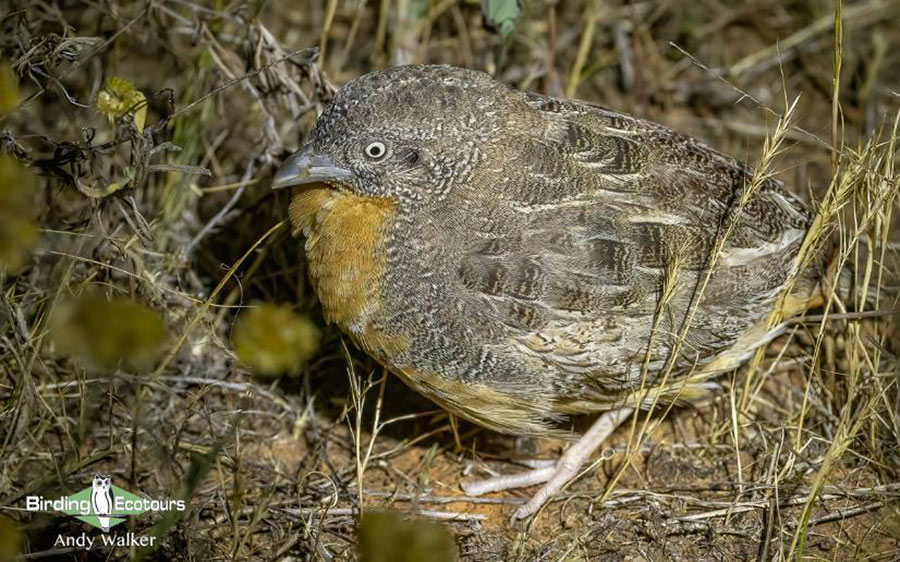
A massive bonus bird during our spotlighting session was this gorgeous adult female Red-chested Buttonquail .
Day 5, 3 rd November 2023. Deniliquin to Ouyen
After our late-night birding session the previous day, we made a later start today. After a relaxed breakfast in Deniliquin we birded near town, finding a number of parrots, including our main target for the morning, Superb Parrot . We also enjoyed sightings of Sulphur-crested Cockatoo , Little Corella , Long-billed Corella , Galah , Crimson (Yellow) Rosella , Eastern Rosella , Red-rumped Parrot , and Rainbow Lorikeet . Other birds here included Noisy Friarbird, Little Friarbird , White-plumed Honeyeater , Brown Treecreeper , and Sacred Kingfisher .
A wetland near the town of Kerang was absolutely heaving with birds and was a special sight to see. We added loads of new birds to our list, including some good ones. Highlights here were Australian Pelican , Black Swan , Australian Shelduck , Pink-eared Duck , Hardhead , Hoary-headed Grebe , Great Cormorant , Glossy Ibis , White-necked Heron , Great Egret , Royal Spoonbill , Banded Stilt , Pied Stilt , Red-necked Avocet , Black-tailed Nativehen , and Whiskered Tern (along with lots more). A few small passerines were noted along the edge of the wetland, such as White-winged Fairywren and White-fronted Chat .
We continued our journey to Ouyen, where we arrived in the evening. Along the way we spotted Cockatiel , Budgerigar , Greater Bluebonnet , Spotted Harrier , White-browed Woodswallow , Masked Woodswallow , Black-faced Woodswallow , Southern Whiteface , Rufous Fieldwren , Chestnut-rumped Thornbill , and Australian Raven .
Day 6, 4 th November 2023. Birding Hattah-Kulkyne National Park
We had an early morning birding session near Ouyen, where we found a beautiful pair of Rainbow Bee-eaters looking glorious in the morning light. We also found our first Purple-backed Fairywrens and White-browed Babblers of the tour here. Brown Goshawk , Fairy Martin , White-browed Woodswallow , and Masked Woodswallow were overhead. Nearby, a Peregrine Falcon was perched up on a building and showed well.
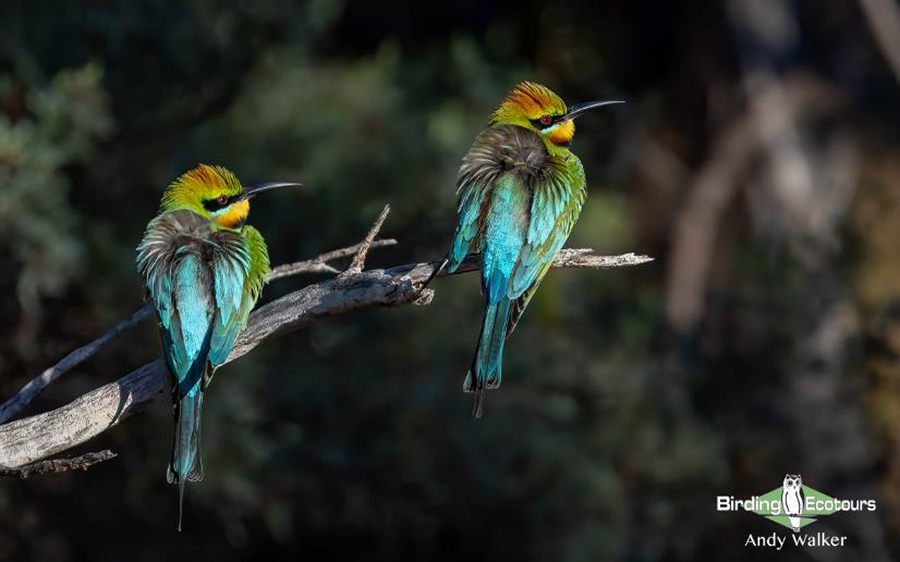
A pair of Rainbow Bee-eaters showed well in the glorious early morning sunlight.
After breakfast we spent the rest of the day birding in the mallee habitats of Hattah-Kulkyne National Park and connected with a range of specialized and localized species with the highlights including Malleefowl and Mallee Emu-wren . There were plenty of other good birds picked up across the day, such as Emu , Regent Parrot , Mulga Parrot , Australian Ringneck , Budgerigar , Splendid Fairywren , White-eared Honeyeater , Yellow-plumed Honeyeater , Shy Heathwren , Inland Thornbill , Crested Bellbird , Gilbert’s Whistler , Australian Raven , Apostlebird , Southern Scrub Robin , and Chestnut-crowned Babbler .
After an early dinner we took a short drive from our accommodation and had the most incredible views of a pair of Pink Cockatoos , (formerly and until recently known as Major Mitchell’s Cockatoo). They dropped out of a tree and drank from a puddle at the side of the road a mere few meters in front of us, displaying their fantastic colorful crests! After the excitement of the cockatoo, we moved to a waterhole where, after a beautiful sunset, we found our main target, a Spotted Nightjar and then a Marble-faced Delma (an uncommon legless lizard). It had been another great day of birding in Australia.
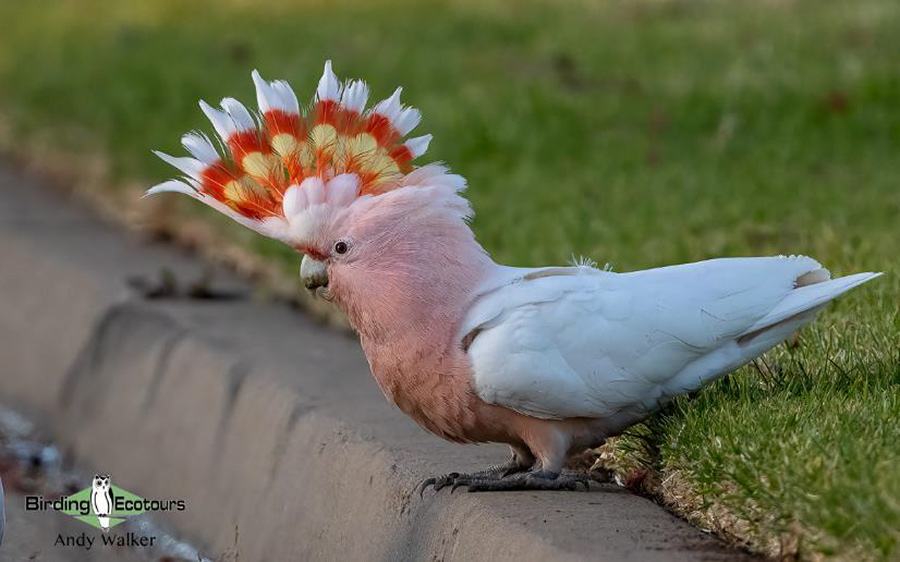
The views of Pink Cockatoo were simply incredible. What a stunning bird.
Day 7, 5 th November 2023. Ouyen to Inglewood
We left Ouyen in the early morning but didn’t get far from our accommodation before we made a stop to enjoy a pair of Fairy Martins sat on a phone wire. A couple of minutes later we found ourselves watching a pair of Pink Cockatoos , possibly the same pair we saw the previous evening. Further prolonged views of this most attractive of cockatoos were enjoyed by everyone. As we left Ouyen we found two more of our regional targets, firstly Red-backed Kingfisher and secondly White-backed Swallow . Both showed well, but the kingfisher was extra showy, perching close to us.
We moved down to the Sea Lake area , where, after breakfast, we visited an attractive pink lake. Here we enjoyed sightings of Rufous Fieldwren , White-winged Fairywren , Brown Falcon , Little Eagle , and Orange Chat .
In the late morning we made the majority of our drive to Inglewood, our base for the night. We stopped at Mount Korong where we saw Spotted Harrier , Peregrine Falcon , Painted Honeyeater , and several Diamond Firetails and many other birds. Closer to Inglewood we found a waterhole that was, for a while, heaving with honeyeaters. We found White-fronted Honeyeater , White-eared Honeyeater , Yellow-plumed Honeyeater , Yellow-tufted Honeyeater , and Brown-headed Honeyeater . However, the activity was suddenly curtailed by an unseen raptor that flew through the area. We moved on to a different patch of bush, where we saw Western Whistler , Gilbert’s Whistler , Purple-backed Fairywren , Inland Thornbill , and Collared Sparrowhawk .
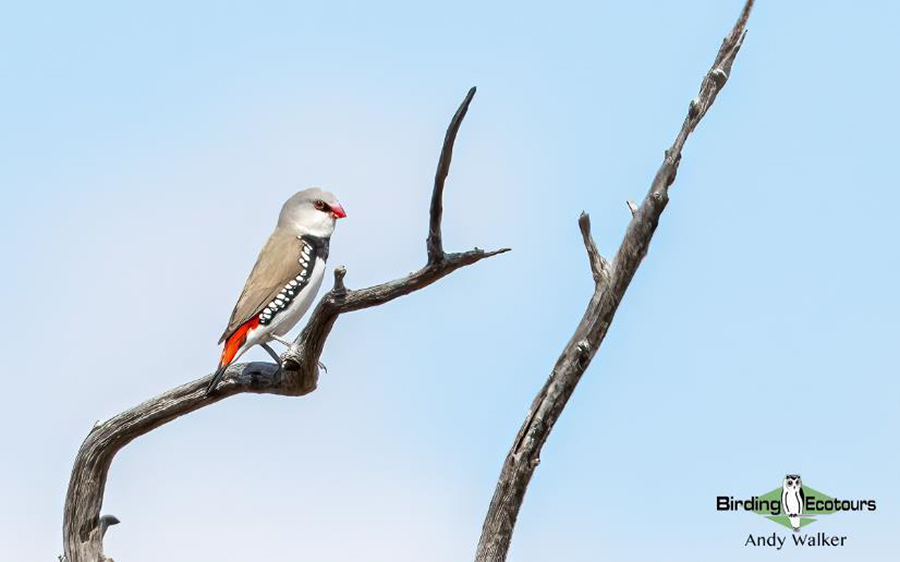
Diamond Firetail is an attractive finch and we had good views of several birds coming to drink at a waterhole.
Day 8, 6 th November 2023. Inglewood to Airey’s Inlet
We left Inglewood in the early morning and made our way to a nearby seasonally flooded swamp. We spent a couple of hours scanning the area, finding several new birds and improving views of several others, including Red-kneed Dotterel , Black-fronted Dotterel , Masked Lapwing , Black-tailed Nativehen , Royal Spoonbill , Yellow-billed Spoonbill , Australian Shelduck , Australasian Grebe , White-necked Heron , White-bellied Sea Eagle , White-breasted Woodswallow , and Rufous Songlark . We even had a great view of a Yellow-footed Antechinus out in the open.
After the wetland birding and breakfast we visited a couple of different blocks of forest, finding Brown Goshawk , Crimson Rosella , Eastern Rosella , Eastern Spinebill , Yellow-tufted Honeyeater , Fuscous Honeyeater , Yellow-faced Honeyeater , White-browed Babbler , Black-faced Cuckooshrike , Grey Shrikethrush , Olive-backed Oriole , Masked Woodswallow , White-browed Woodswallow , White-winged Chough , Spotted Pardalote , Weebill , Striated Thornbill , Buff-rumped Thornbill , Varied Sittella , Mistletoebird , and Scarlet Robin .
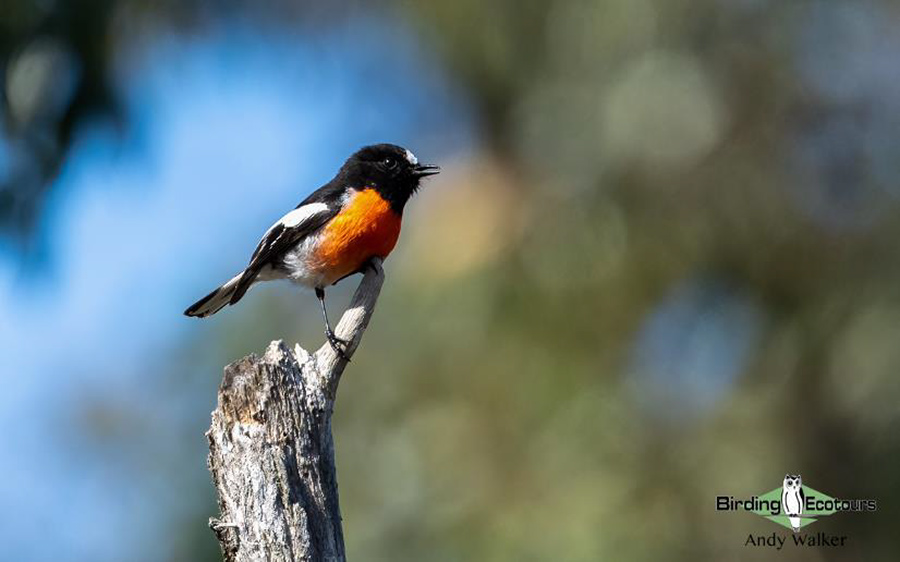
Scarlet Robin gave us some good views.
After lunch we made the journey down to Airey’s Inlet. We stopped at the town of Lara along the way, where we had a great birding session. Top sightings here included Cape Barren Goose , Latham’s Snipe , Australian Crake , Australasian Swamphen , Royal Spoonbill , Musk Lorikeet , Purple-crowned Lorikeet , Little Grassbird , Australian Reed Warbler , Golden-headed Cisticola , European Goldfinch , European Greenfinch , and Eurasian Tree Sparrow .
Day 9, 7 th November 2023. Airey’s Inlet to Melbourne
The final day of our Victoria birding circuit (which included a brief foray into New South Wales), saw us start the day with some birding at Airey’s Inlet . We found our target Rufous Bristlebird , with several birds seen briefly at first, with lots of song, but then a pair of birds showed well in the scrub. A few Australian Gannets were noted offshore here. Because everyone on this tour had taken part in our Tasmania bird tour immediately prior to this tour, we opted to skip our usual other birding sites and target birds in the area as several of the usual target birds had already been seen well on the Tasmania tour. This decision allowed us to spend some extra time in the wonderful and bird-filled Werribee Western Treatment Plant (WTP).
Birding at Werribee WTP was excellent and we recorded over 85 species across a few hours at the site. The list of highlights is long (see the eBird list here ), and included Brolga , Cape Barren Goose , Musk Duck , Blue-billed Duck , Pink-eared Duck , Australasian Shoveler , Australian Crake , Baillon’s Crake , Buff-banded Rail , Banded Stilt , Red-capped Plover , Sharp-tailed Sandpiper , Curlew Sandpiper , Red-necked Stint , Common Greenshank , Marsh Sandpiper , Black-tailed Godwit , Bar-tailed Godwit , Pied Cormorant , Royal Spoonbill , Yellow-billed Spoonbill , Glossy Ibis , Australian Pelican , Great Crested Grebe , Hoary-headed Grebe , Australasian Grebe , Whiskered Tern , Swamp Harrier , White-fronted Chat , Golden-headed Cisticola , Australian Reed Warbler , Little Grassbird , Brown Songlark , and Fairy Martin . Wildfowl and shorebirds were present in the thousands, and it was a seriously impressive sight. We could have easily spent a week going around the site!
After our birding at Werribee WTP, we said farewell to our local guide, Simon, who had once again given us some once-in-a-lifetime birding memories and a fun trip.

Rufous Bristlebird was skulking in the undergrowth but came out a couple of times for some quick photos.
Day 10, 8 th November 2023. Melbourne to Brisbane, Brisbane birding and travel to O’Reilly’s Rainforest Retreat
We departed Melbourne for our flight to Brisbane in southern Queensland. Everything went smoothly and we arrived in the late morning. After collecting our vehicle, we took a short drive to the beach, where we had a picnic lunch and found the localized duo of Mangrove Honeyeater and Mangrove Gerygone . Our next stop was just to the south of Brisbane, where we found one of the top mammalian targets of the tour, Koala . We found two of them, a male and a female and got some nice views of these very special animals. To add to the exciting experience here, we also found a pair of Tawny Frogmouths at their nest, complete with two young nestlings. Around Brisbane we picked up several other birds, such as Channel-billed Cuckoo , Scaly-breasted Lorikeet , Brown Cuckoo Dove , White-bellied Sea Eagle , Brahminy Kite , Torresian Crow , Grey Butcherbird , and more.
We left the city behind to commence our drive up into the mountains for our stay at O’Reilly’s Rainforest Retreat. Along the way, we made a brief stop to look at a roost of Grey-headed Flying Foxes and Little Black Flying Foxes . As we made the final ascent up the mountain we spotted a pair of Glossy Black Cockatoos , Wonga Pigeon , Red-necked Wallaby and Whiptail Wallaby . As we checked in to our accommodation, we were distracted by the magical sight of four Regent Bowerbirds (see photo in the trip report summary) sitting right in front of us. Add in the Australian King Parrots and Crimson Rosellas all around us and it was a pretty impressive welcoming committee!
Day 11, 9 th November 2023. Birding at O’Reilly’s Rainforest Retreat
We had a sensational day of birding at O’Reilly’s in Lamington National Park . We had an early start to maximize our time here and were handsomely rewarded. The first bird we saw in the morning was the highly localized Albert’s Lyrebird . It was a brief sighting of a shy bird, so we were left wanting a bit more. We moved to our next spot, where we had some really good views of several White-headed Pigeons , along with Eastern Yellow Robin and Australian Brushturkey . Both Regent Bowerbird and Satin Bowerbird were seen very well, as were Australian King Parrot and Crimson Rosella .
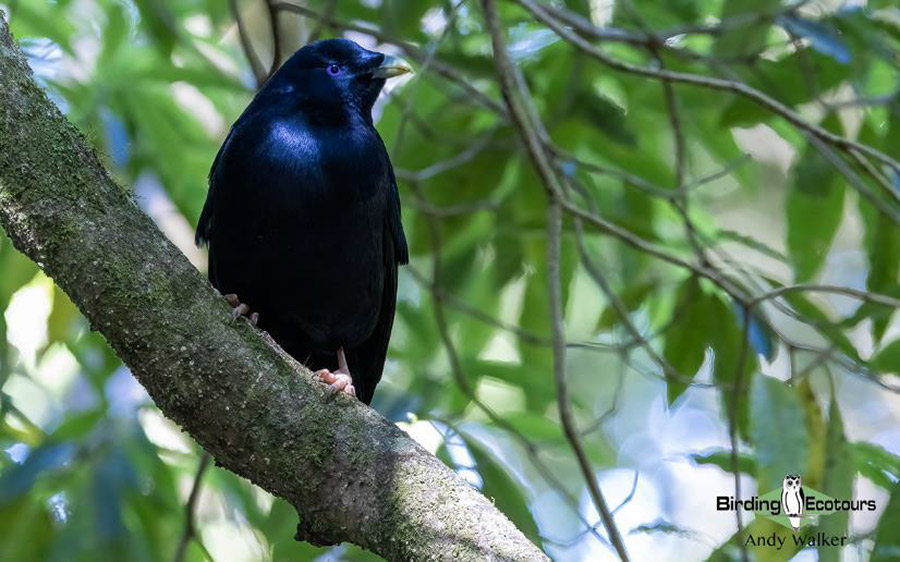
Satin Bowerbird is easily found at O’Reilly’s Rainforest retreat and looks gorgeous in the correct light.
Entering the forest, we focused on the lyrebird and enjoyed a remarkable sighting of a pair of Albert’s Lyrebirds . The female gave some prolonged views as she foraged on the ground, then the male of the pair walked in, before it bounced up and flew high into a tree, where it continued to forage in a bird’s-nest fern, a remarkable and rarely seen behavior. After the lyrebird, which we watched for quite a while, we then also saw a pair of Noisy Pittas . As we walked to the restaurant for breakfast, we noted Wedge-tailed Eagle , Topknot Pigeon , Pied Currawong , Scarlet Myzomela , Eastern Spinebill , and Red-browed Finch .
After breakfast we took a forest walk where we concentrated on good views of the local birds, and these included common birds like Grey Shrikethrush , White-browed Scrubwren , Yellow-throated Scrubwren , Large-billed Scrubwren , Brown Gerygone , Brown Thornbill , Australian Golden Whistler , and Eastern Yellow Robin . Highlights during this birding session included excellent sightings of Paradise Riflebird (a male giving prolonged views), Eastern Whipbird , Rufous Fantail , Black-faced Monarch , Australian Logrunner , Green Catbird , and Bassian Thrush , not to mention the parrots and bowerbirds also enjoyed all morning! We found a giant Land Mullet (a very large skink) and just before lunch we saw our first Bush Stone-curlew of the tour.
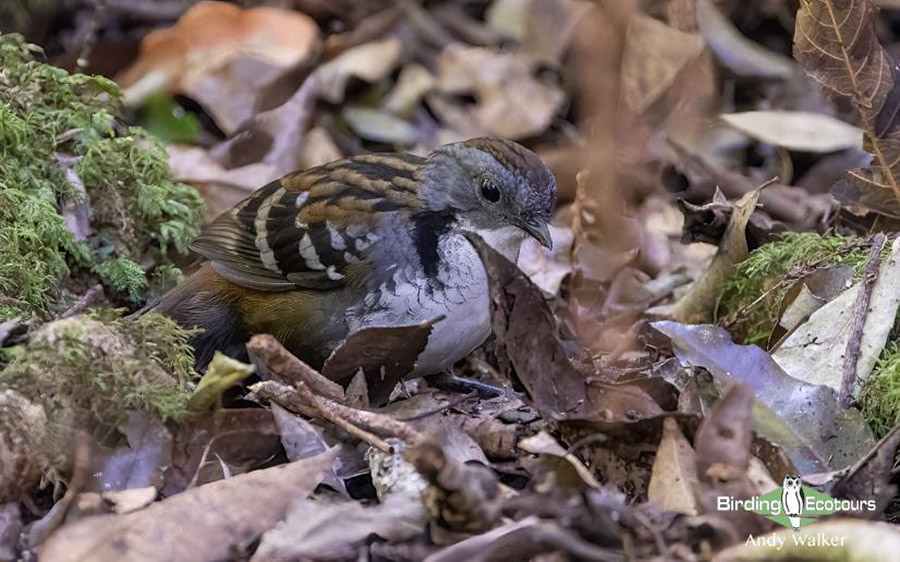
With patience, it is possible to get great views of the interesting Australian Logrunner in the forest at O’Reilly’s Rainforest Retreat.
After a bit of a break in the early afternoon we headed back out onto the trails at O’Reilly’s for a brief walk. Again, we enjoyed many of the common birds of the area, but also spent time watching a female Paradise Riflebird and several Green Catbirds foraging in the tall rainforest trees. A Wonga Pigeon was walking around on a lawn, and we again had sightings of Albert’s Lyrebird . After another wonderful dinner at O’Reilly’s Rainforest Retreat, we took a walk back to our accommodation, finding Short-eared Brushtail Possum , Common Ringtail Possum , Red-legged Pademelon , and a roosting Russet-tailed Thrush !
Day 12, 10 th November 2023. Birding at O’Reilly’s Rainforest Retreat, travel to Brisbane then flight to Cairns.
We woke to a damp morning and were instantly grateful for the beautiful day we’d had yesterday, along with all of those great birds. As usual at O’Reilly’s, the great birds are never too far away, and right outside our rooms this morning we found several male Regent Bowerbirds , Satin Bowerbird , Australian King Parrot , Crimson Rosella , and best of all, a very showy male Paradise Riflebird . After a short walk, where we improved our views of Bassian Thrush , we had breakfast and reluctantly departed to Brisbane.
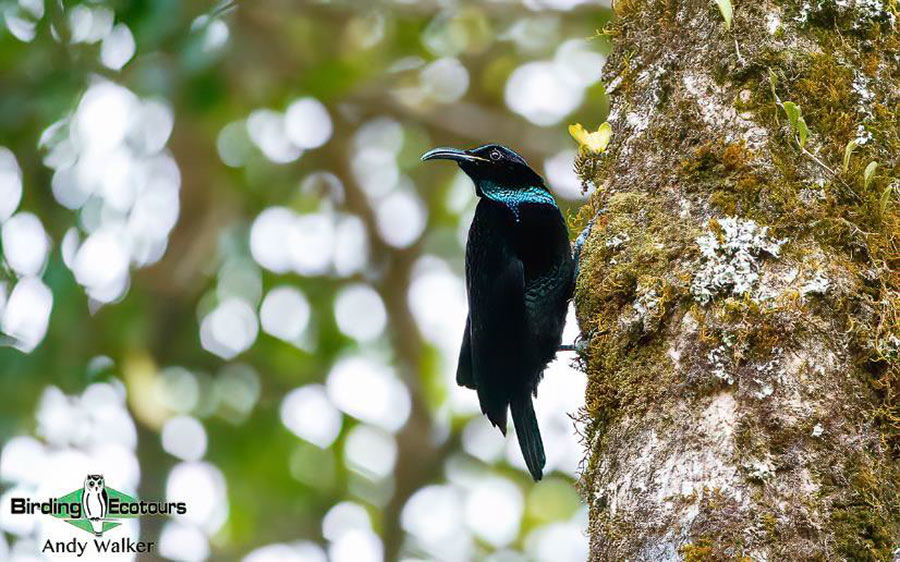
Paradise Riflebird gave some very close views at O’Reilly’s Rainforest Retreat.
Once back in Brisbane we caught our flight to Cairns in Far North Queensland. A whole new set of birds was awaiting us and after checking into our beachside hotel we had a brief birding session on the famous Cairns Esplanade where we found Australian Swiftlet , Torresian Imperial Pigeon , Australasian Figbird , Hornbill Friarbird , and Varied Honeyeater . The tidal state was not conducive for shorebirds, but there were three Black-fronted Dotterels and a pair of Masked Lapwings near our dinner restaurant.
Day 13, 11 th November 2023. Great Barrier Reef trip and travel to Mission Beach
A walk along the Cairns Esplanade prior to our Great Barrier Reef boat trip gave us a few good birds, such as Pacific Golden Plover , Great Knot , Bar-tailed Godwit , Curlew Sandpiper , and Australian Pelican along the beach, with Torresian Imperial Pigeon , Nankeen Night Heron , Peaceful Dove , Australasian Figbird , and Brown Goshawk all also recorded. There was also a gathering of several Bush Stone-curlews in a car park!
The reef trip was, as always, an enjoyable day with lots of interesting birds seen well, such as Bridled Tern , Sooty Tern , Greater Crested Tern , Lesser Crested Tern , Brown Booby , Brown Noddy , and more (many of these birds breeding on Michaelmas Cay). In addition to the great views of the seabirds, we also enjoyed sightings of Leatherback Turtle , and some spectacular reef fish. After getting back to Cairns in the mid-afternoon, we drove south to Mission Beach for the night and enjoyed a celebratory dinner together.
Day 14, 12 th November 2023. Birding Mission Beach and Atherton Tablelands
Another enjoyable day seeing some of the top birds and wildlife found in Australia. We started the day in Mission Beach, where we quickly found a Southern Cassowary . It was a brief view of a male slowly crossing a road right in front of us before it just melted away into the forest. Incredible, and a sighting that won’t be forgotten anytime soon. After enjoying the Southern Cassowary sighting in Mission Beach, we picked up several other birds, such as White-throated Needletail , Bar-shouldered Dove , Pheasant Coucal , Brush Cuckoo , Bush Stone-curlew , Osprey , Red-tailed Black Cockatoo , Azure Kingfisher , Forest Kingfisher , Yellow-spotted Honeyeater , Brown-backed Honeyeater , Dusky Myzomela , Varied Triller , Fairy Gerygone , Olive-backed Sunbird , and an impressive nesting colony of the vociferous Metallic Starlings .
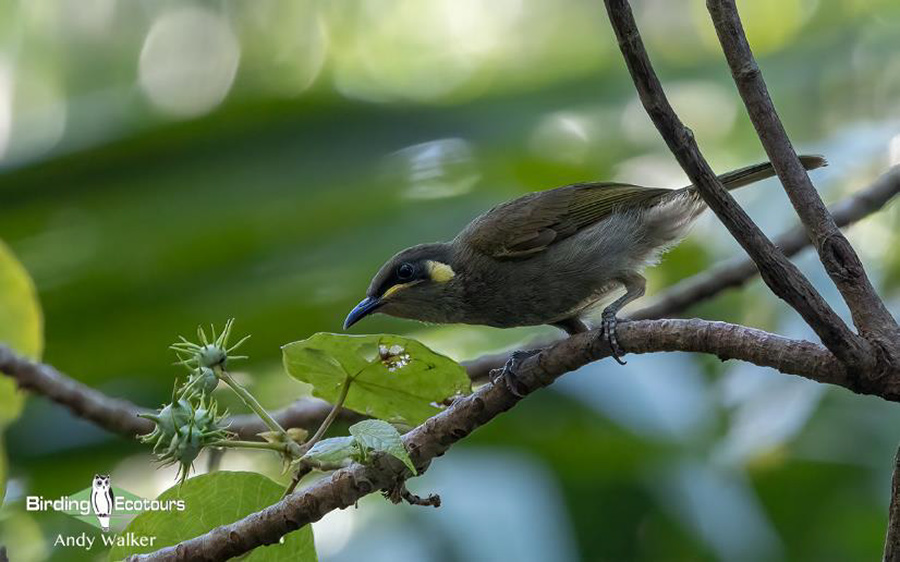
Yellow-spotted Honeyeater was heard and seen plenty of times during the day.
After leaving the coast in the middle of the morning, we stopped in at some rainforest, where we had sightings of Grey Goshawk , Spectacled Monarch , Pied Monarch , Victoria’s Riflebird (very briefly), Rufous Shrikethrush , Barred Cuckooshrike , Cryptic Honeyeater , and Pale-yellow Robin .
We enjoyed some lunch at Lake Eacham , and afterwards took a short walk through some more rainforest, where we saw Tooth-billed Bowerbird , Spotted Catbird (briefly), White-throated Treecreeper , Oriental Dollarbird , Grey-headed Robin , and Macleay’s Honeyeater .
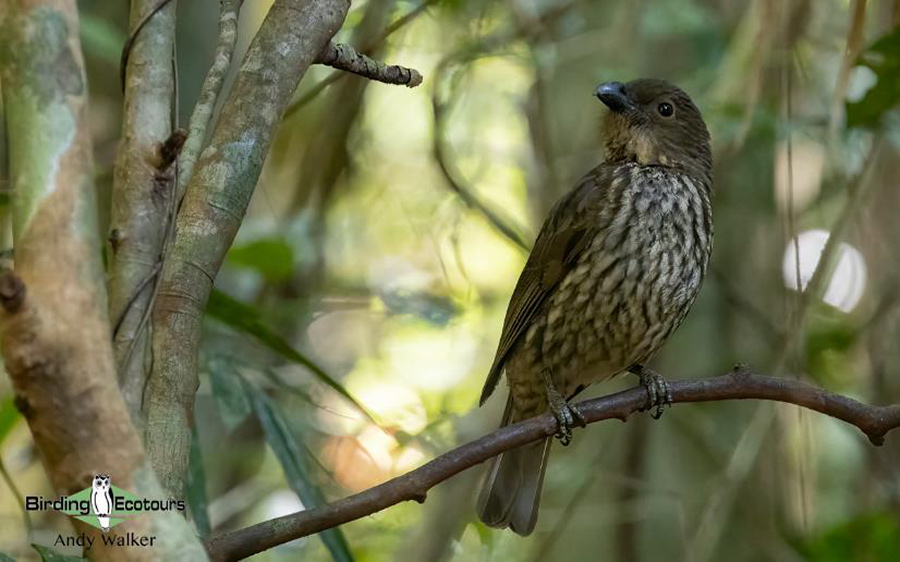
The range-restricted Tooth-billed Bowerbird gave some good views at his bower.
After checking into our rainforest accommodation, we visited a quiet river, where we found another of the most-wanted animals in Australia, the Platypus . We enjoyed prolonged views as one foraged right in front of us. We saw quite a few interesting mammals here and back at our accommodation in the late-afternoon and evening, including Agile Wallaby , Red-necked Pademelon , Musky Rat Kangaroo , Yellow-footed Antechinus , Bush Rat , Long-nosed Bandicoot , Spectacled Flying Fox , and Sugar Glider .
Day 15, 13 th November 2023. Birding the Atherton Tablelands
We spent the day birding in the Atherton Tablelands , visiting a few different sites and habitats. In the morning, around our accommodation, we found Victoria’s Riflebird , Spotted Catbird , Tooth-billed Bowerbird , Barred Cuckooshrike , White-bellied Cuckooshrike , Wompoo Fruit Dove , Brown Cuckoo Dove , Grey-headed Robin , Rufous Shrikethrush , and more.
After breakfast we moved across to the Curtain Fig Tree National Park where we marveled at the giant and impressive fig tree, complete with an attractive Boyd’s Forest Dragon and showy male Australian Golden Whistler . Nearby we found Brolga , Sarus Crane , Spotted Harrier , Black Kite , Whistling Kite , Black-shouldered Kite , and Brown Falcon . A real treat was a Feral Dog (Dingo) which came purposefully through our view before disappearing into some tall vegetation.
Our next stop was the wonderful Hasties Swamp where we were greeted by thousands of Plumed Whistling Ducks and the highly anticipated Magpie Goose . Seeing and hearing vast numbers of these birds is always a thrill. At the swamp, we also found Wandering Whistling Duck , Hardhead , Grey Teal , Great Egret , Intermediate Egret , Nankeen Night Heron , Sarus Crane , Brolga , Australian Pelican , Royal Spoonbill , Australasian Darter , Red-kneed Dotterel , Black-fronted Dotterel , Sharp-tailed Sandpiper , and Forest Kingfisher .
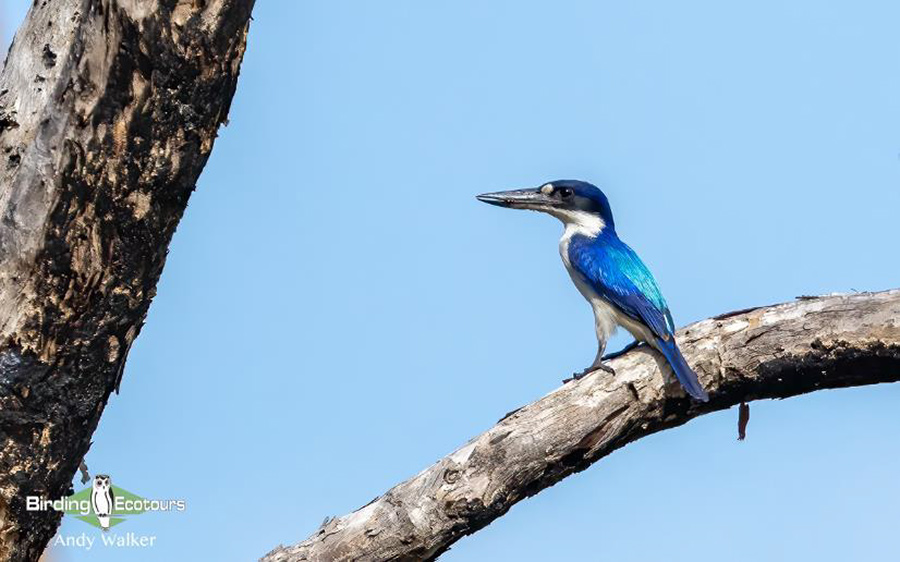
Forest Kingfisher was glowing!
After lunch and a short break, we visited a small patch of rainforest, where, with a lot of searching, we found a family group of the tough-to-see, Lumholtz’s Tree Kangaroos . Another mammalian Australian tour highlight, for sure. After our dinner we went on a night safari, looking for birds, reptiles, and mammals, and it was highly successful. During a visit to some rainforest, we saw Lesser Sooty Owl , Bush Stone-curlew , Striped Possum , Green Ringtail Possum , Common (Coppery) Brushtail Possum , Long-nosed Bandicoot , Giant White-tailed Rat , Red-legged Pademelon , Northern Leaf-tail Gecko , Boyd’s Forest Dragon , and Amethystine Python .
Day 16, 14 th November 2023. Birding the Atherton Tablelands and Mareeba area
We started our day birding at Lake Eacham, getting the morning started with great views of Victoria’s Riflebird , Spotted Catbird , Superb Fruit Dove , Pacific Emerald Dove , Double-eyed Fig Parrot , Barred Cuckooshrike , and many more top-quality birds.
After breakfast we left Lake Eacham for Mount Hypipamee. A stop along the way gave us Tawny Grassbird , Golden-headed Cisticola , Chestnut-breasted Mannikin , three huge Channel-billed Cuckoos , and the goliath Wedge-tailed Eagle at close range. On arrival at our next rainforest birding patch, we headed into the forest and staked out a Golden Bowerbird bower. We got brief views of an adult male, followed by a female, and then an immature male that gave brilliant prolonged and close views. Further exploration of the forest resulted in sightings of Amethystine Python , Bridled Honeyeater , Bower’s Shrikethrush , Mountain Thornbill , Atherton Scrubwren , Pied Monarch , Pale-yellow Robin , Pacific Baza , and Peregrine Falcon .
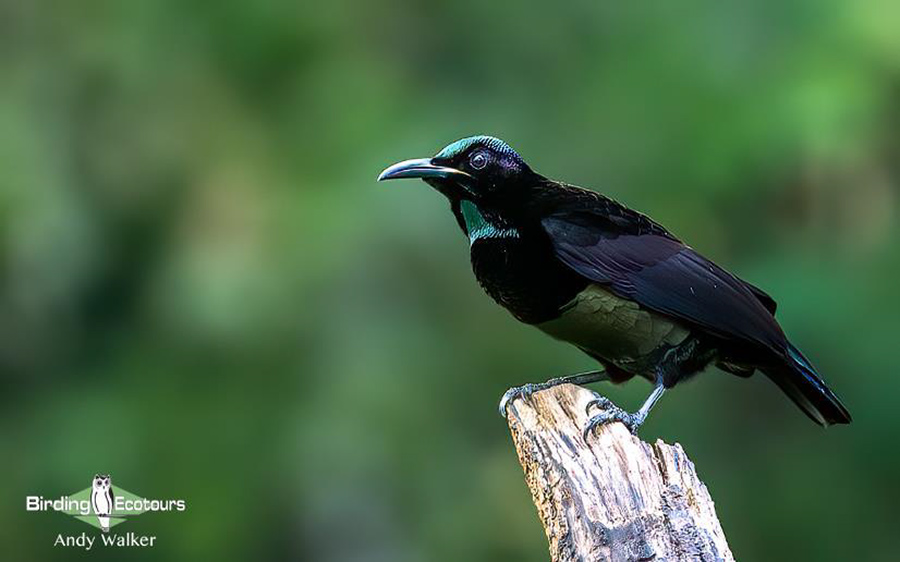
Victoria’s Riflebird was the second bird-of-paradise enjoyed on this Australian bird tour.
After lunch we came off the fertile Atherton Tablelands and down into the drier zone around the small town of Mareeba. We visited Granite Gorge, where we had excellent close looks at the rather cute Mareeba Rock Wallaby , but also found some good birds, with the highlights (of which there were many), including Great Bowerbird (meticulously attending to his bower), Squatter Pigeon , Pale-headed Rosella , Wedge-tailed Eagle , Green Oriole , Olive-backed Oriole , Yellow Honeyeater , Leaden Flycatcher , and more.
After checking into our accommodation on the edge of town, we birded at a site just outside Mareeba, where we added a few new species to our list, such as displaying Australian Bustards , Australian Hobby , Red-backed Fairywren , and Blue-winged Kookaburra .
Day 17, 15 th November 2023. Birding from Mareeba to the Mount Lewis area, Daintree River dusk boat trip, and travel to Cairns
We spent the morning birding in the dry habitats near Mareeba, where we saw Red-winged Parrot , Red-tailed Black Cockatoo , Lemon-bellied Flyrobin , White-throated Honeyeater , Yellow Honeyeater , Brown Honeyeater , Brush Cuckoo , Sacred Kingfisher , and Blue-winged Kookaburra . An area of swamp was full of birds, including the giant Black-necked Stork and Brolga , along with Radjah Shelduck , Red-kneed Dotterel , and lots more, including numerous Black Kites and Whistling Kites .
We followed up the dry country birding with some time in mixed eucalyptus and rainforest (which was also actually quite dry this year), where we found Lovely Fairywren , Northern Fantail , Rufous Fantail , Superb Fruit Dove , Pale-yellow Robin , and Yellow-breasted Boatbill .
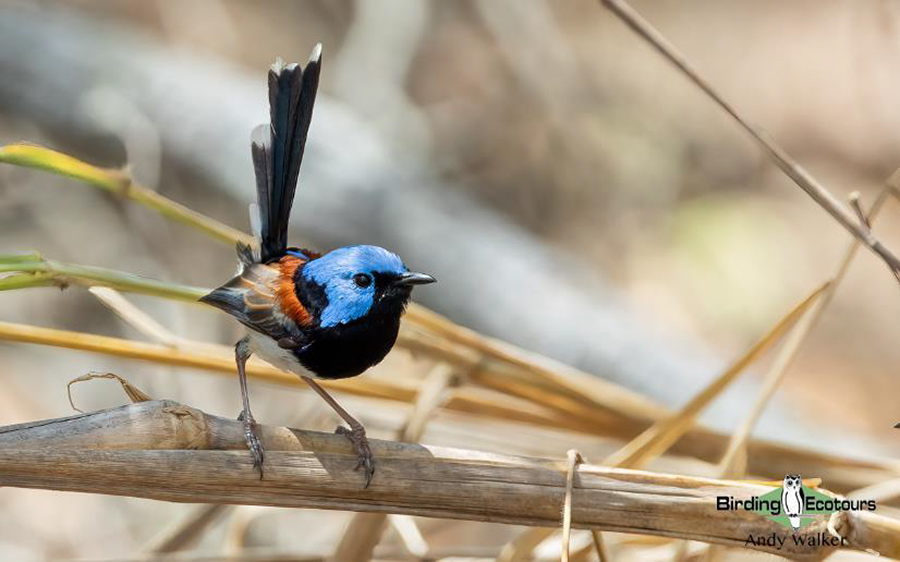
A pair of Lovely Fairywrens were enjoyed on our final full day of birding on this Australian bird tour, this male showed very well.
In the afternoon, we had a final couple of rainforest patches to check, and we were successful in finding a pair of Papuan Frogmouths and then the spectacular Buff-breasted Paradise Kingfisher , the latter a fresh arrival from New Guinea and staking a claim to his summer breeding territory.
The final birding of the day was on the Daintree River , where we enjoyed a dusk boat cruise, adding several new species for the tour, and improving views and photos of others, including Spotted Whistling Duck , Radjah Shelduck , Papuan Frogmouth , Great-billed Heron , Black Bittern , Azure Kingfisher , Brahminy Kite , Pacific Koel , Green Oriole , Shining Flycatcher , Wompoo Fruit Dove (on a nest), and plenty more. Additional highlights included Green Tree Snake and Saltwater Crocodile sightings.
After enjoying our Daintree River boat trip, we drove back to Cairns for the final night of the tour. During our drive back to Cairns we discussed possible “bird of the trip” candidates, and it was very hard to pick a top bird given all the high-quality birds we’d seen over the previous weeks. Some of the favorites included (in no particular order!); Pink Cockatoo , Red-backed Fairywren , Southern Cassowary , Plains-wanderer , Golden Bowerbird , and Red-chested Buttonquail .
Day 18, 16 th November 2023. Birding Cairns Esplanade and t our concluded with departure from Cairns
We had a final breakfast in Cairns and said goodbye to Steve, who had been an excellent and incredibly knowledgeable local guide during our time in Queensland. We had a final, short birding session along Cairns Esplanade as the tidal situation was perfect. Numbers of shorebirds were lower than is often the case at this time of year, but we added several new species for the tour, including Pacific Reef Heron , Australian Tern , Caspian Tern , Far Eastern Curlew , Eurasian Whimbrel , and Grey-tailed Tattler . We also gained some very close views of other species seen previously, such as Bar-tailed Godwit , Common Greenshank , Curlew Sandpiper , Pied Stilt , Black-fronted Dotterel , Silver Gull , and Little Tern .
With our final birding session complete it was time for saying goodbye. It had been an incredibly fun tour, with lots of laughs along the way, as well as been packed full of some of the best birds of Australia and some of the most wanted mammals on the continent. A huge thank you to everyone for making this such a fantastic tour, I look forward to traveling with you all again soon. Trip lists for birds, other wildlife, and interesting plants follow.
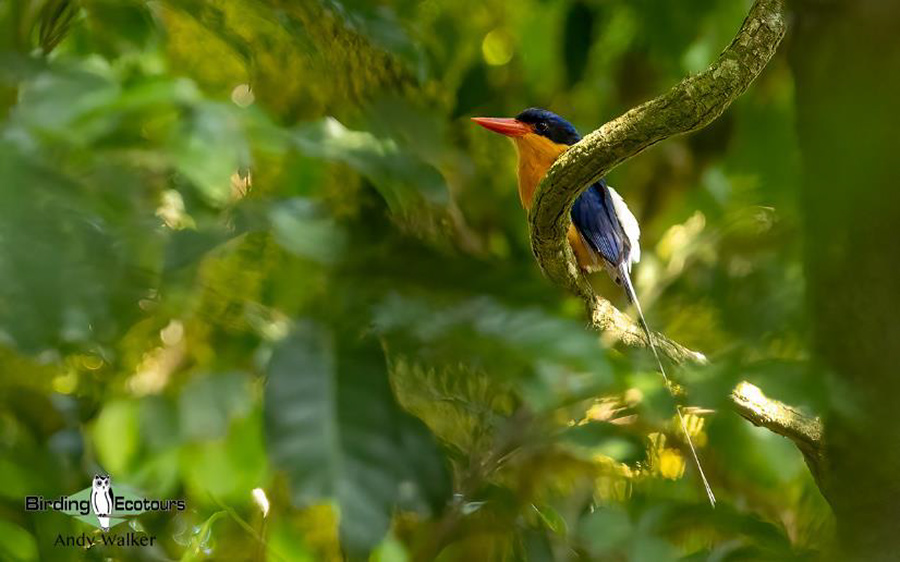
Buff-breasted Paradise Kingfisher was a final highlight of the rainforest element of this Australian birding tour.
Bird List – Following IOC (13.2)
Birds ‘heard only’ are marked with (H) after the common name, all other species were seen. The following notation after species names is used to show conservation status following BirdLife International : EN = Endangered, VU = Vulnerable.
Mammal List
Reptile list, notable other taxa list.
This is a sample trip report. Please email us ( [email protected] ) for more trip reports from this destination.
Birding Tour Australia: Eastern Australia – From The Outback To The Wet Tropics
Tour-specific information.
GENERAL INFORMATION ABOUT AUSTRALIA CAN BE READ HERE
TOUR OUTLINE
This is a comprehensive birding tour of eastern Australia . The first leg of our eastern Australian bird tour starts in Melbourne, Victoria. It makes a circuit around the southeastern Australian state (including a brief foray into southern New South Wales, where we will make a nocturnal trip for the monotypic and extremely rare Plains-wanderer ) before returning to Melbourne. The second leg of the tour sees us flying from Melbourne to Brisbane in southern Queensland; here, we will visit the fantastic O’Reilly’s Rainforest Retreat . After our birding in Lamington National Park, we will fly north from Brisbane to Cairns (Far North Queensland) for the third and final leg of the tour. From Cairns, we will make a circuit of the fertile and rainforest-clad Atherton Tablelands and the adjacent dry country lower down in the foothills. While in Queensland, our tour also includes a boat trip to the Great Barrier Reef and a boat cruise along the Daintree River. We will finish up our eastern Australian birdwatching tour back in Cairns, where the tour will conclude.
This is our most popular Australian birdwatching tour. There are a lot of simply incredible birds possible on this eastern Australia birding tour (which also combines perfectly with our Tasmania bird tour, which many people choose to do). Top highlights include Southern Cassowary , Malleefowl , Superb Lyrebird , Albert’s Lyrebird , Brolga , Rufous Scrubbird , Regent Bowerbird , Satin Bowerbird , Golden Bowerbird , Great Bowerbird , Green Catbird , Paradise Riflebird , Victoria’s Riflebird , Australian King Parrot , Gang-gang Cockatoo , Pink (Major Mitchell’s) Cockatoo , Superb Parrot , Shy Heathwren , Striated Fieldwren , Mallee Emu-wren , Superb Fairywren , White-winged Fairywren , Striated Grassbird , Australian Logrunner , Chowchilla , Painted Honeyeater , and Diamond Firetail . This Australian bird tour also offers some excellent and emblematic Australian mammals, such as Platypus , Short-beaked Echidna , Koala , Lumholtz’s Tree Kangaroo , and Red Kangaroo . A high-quality list of reptiles, amphibians, and other critters can be enjoyed too. This is the best birding tour if you’ve never visited Australia before.
The Victoria section of this Australian bird tour may run in reverse to the order advertised in the itinerary, based on the availability of accommodation and local guides. On some occasions, we need to run the tour in reverse, e.g., starting in Cairns and ending in Melbourne with Brisbane in the middle. We will go to exactly the same places but just in the opposite order shown in the online itinerary. Please confirm the order of the route with us prior to purchasing your international flight tickets for the start and end of the tour.
DAILY ACTIVITIES, PHYSICAL REQUIREMENTS, AND TOUR PACE
Our comprehensive eastern Australia birding tour moves at quite a fast pace. We will cover a lot of ground on this Australian birdwatching tour, with a big overland circuit of the western side of Victoria (starting and ending at Melbourne airport) and including a trip into southern New South Wales at Deniliquin. In Victoria, we will visit the towns of Healesville, Wangaratta, Ouyen, Inglewood, and Airey’s Inlet. We will take two domestic flights during our bird tour, Melbourne to Brisbane and Brisbane to Cairns. There will be less driving in Brisbane (southern Queensland) as most of our time will be spent on foot around O’Reilly’s Rainforest Retreat, once we get there, after some birding in the Brisbane mangroves. In northern Queensland, we will take a boat trip onto the Great Barrier Reef, then make a circuit from Cairns south along the coast to Mission Beach, before coming inland and up onto the fertile Atherton Tablelands. After birding the tablelands, we will drop down to the dry north for a different set of birds, before finishing up back at Cairns after a boat cruise along the Daintree River. There is less driving in northern Queensland than in Victoria. This Australian bird tour will cover a wide range of habitats and a big trip list of 375 – 400 bird species should be expected.
In Victoria, we will have long drives of 4 – 6 hours on most days to get between different birding areas. In Queensland, we will have drives of 2 – 3 hours. We will usually have a pre-breakfast early morning birding session and then, after breakfast, do a little more birding in our local area before the heat increases and bird activity drops. We then move off to our next area. We will usually aim to make the drives across the middle of the day and break them up with lunch stops and restroom/coffee breaks.
The tour is generally considered easy to moderate in terms of physical exertion. However, the inland temperatures during the day, even during the spring period, could get high (see the “Weather” section below), so dehydration needs to be always considered a possibility, as does heat stroke and sunburn, etc.
In Victoria, we tend to make short and productive walks from our vehicle in a loop of up to 0.6 – 1.2 miles (1 – 2 kilometers/km), and we may make several of these a day. On a couple of occasions in Victoria, we are likely to make slightly longer walks of 2.5 miles (4 km). In Lamington National Park, we will spend most of our time on foot walking around the forest trails and roads (as well as mooching around the excellent retreat gardens). We will usually make a pre-breakfast walk of 1.2 miles (2 km), a post-breakfast walk of 3.5 – 5 miles (6 – 8 km), and then a late afternoon walk of a similar distance. All walks at O’Reilly’s are totally optional. If you’d rather sit in the garden soaking up the wonderful birds on offer, such as Crimson Rosella , Australian King Parrot , Regent Bowerbird , and Satin Bowerbird , that’s totally fine. In the tropical north of Queensland, we will make short walks of 0.6 – 1.2 miles (1 – 2 km) at different sites, and we might make several of these a day. We usually walk from our hotel to the quay to meet our reef trip boat, this is 0.6 miles (1 km). The trail at Mount Lewis is the hardest trail as it involves some incline and maneuvering around fallen trees and some rocks, but it’s still relatively easy, and we will take it at a slow birding pace. Walking in Victoria is often on fairly flat but rough (uneven) ground with rabbit holes and loose rocks, so care needs to be taken. In some areas, such as the mallee habitats, we will be walking in very spiky spinifex grass. Snakes should always be considered when on foot on the whole tour route.
We will make a few general nighttime trips for nocturnal birds and wildlife during the tour (weather permitting), as well as the specific Plains-wanderer trip (see details below). Most owling/mammal-watching sessions will last an hour or so, usually after dinner, and these are all optional.
TRANSPORTATION
We will use 12-seater minibuses on this tour; these will be collected in each city we arrive in and dropped back off there on our return. There will be limited baggage space, so please pack as lightly as possible for the tour (including within the seating area). We will have some long drives on the tour, particularly in Victoria (often on long straight roads). Some of the drives, particularly in Queensland, will involve long and windy mountain roads, so if you suffer from motion sickness, you might want to be prepared for that (e.g., the drive up to and down from O’Reilly’s Rainforest Retreat, the drive up and down Mount Lewis, and as we climb up and drop off the Atherton Tablelands). When we make our Plains-wanderer trip, the group might get split into two vehicles with our local guides; these might be 4×4 Toyota Hilux / Landcruiser-type vehicles. See the “Plains-wanderer Trip” section below for more information.
We will make two boat trips on this tour, see the “Boat Trips” section below, and we will also take two domestic flights during this tour, see the “Domestic Flights” section below.
We will take a boat trip out onto the Great Barrier Reef. This is not a private reef trip, and there will be up to around 30 participants on the boat. This is one of the smaller boats that goes to the reef, and it is usually the first boat there, which means we will likely get to Michaelmas Cay prior to too much disturbance. The boat has a no-shoe policy, so footwear should be removed upon entering. We will be out on the water from around 07:30 hrs. to around 15:00 hrs.
The boat has toilets, and we will have meals (a morning snack and lunch) and drinks onboard. You will need to bring your own personal water supply for the day, though additional drinks can be purchased throughout the day whilst on the boat. We will get on and off the boat in Cairns Marina, so this is a dry boarding/disembarking. There are opportunities for diving and snorkeling while on this trip – which is highly recommended. The reef trip company does not supply towels; usually, our hotel in Cairns will allow us to take a beach towel for the day for a small deposit.
The boat has a medium-sized lounge with air-conditioning as well as a top deck with seating (no aircon here, but there is often a cooling breeze). It is very easy to get sunburnt on this trip, so please bring plenty of suncream, as well as sunglasses (strong glare) and a sunhat. Swimwear is best worn on the boat as a base layer, and the reef trip company will provide wetsuits (necessary in “stinger season” – which refers to jellyfish present at certain times of the year). The reef trip company provides snorkeling equipment (including a limited supply of prescription masks – for a deposit payable/held on credit card). The reef trip company provides a health and safety questionnaire on arrival, and it is essential that you fill this out with the correct information. The reef trip company’s word on the boat is final, and your health and safety is their (and our) paramount concern.
We will usually try and land on Michaelmas Cay to observe the breeding birds at close range; however, if tidal or weather conditions prevent us from doing so, we will try and circumnavigate the island in a smaller glass-bottomed boat. The exact activities of the day are totally weather and tide-dependent. If you suffer from motion sickness, you may need to take medication for this trip. If we do land on Michaelmas Cay, it will be a wet landing and re-entry, usually up to ankles, rarely your knees; the boat can usually land against the sandy beach.
We will also take a boat trip on the Daintree River during the tour; this is a small boat, like a speedboat. We will journey along the wide Daintree River and then enter smaller, narrower tributaries that take us close into the mangroves, where we are seeking the rarer and more secretive species. The boat has a pop-up cover for the sun, but this inhibits viewing, so we usually try not to use it. We will be exposed to the elements on this trip, so a sunhat, sunglasses, and sunscreen are essential (as well as potentially a rain jacket/poncho if the weather looks threatening). Note on the larger river section we might move quite quickly, so watch out for your hat blowing off! The boat trip is usually around two hours in duration and often starts at dawn or ends at dusk, mainly depending on the tidal situation. Do not dangle your hands out of the boat into the water – there are Saltwater Crocodiles here – see the “Safety” section below.
If you’d like further information on either of these boat trips, please contact us .
DOMESTIC FLIGHTS
This tour requires two domestic flights (Melbourne to Brisbane and Brisbane to Cairns). The costs for these flights are not included in the tour cost. Once we confirm the tour, we will purchase flight tickets for everyone in the group at the same time to ensure we are all on the same flights. The additional cost of flights will be added to your tour balance payment, which is due no later than two months prior to departure. Please refer to the Australia general information document regarding important information on baggage allowance (including carry-on allowance). We usually try and make our domestic flights with Qantas or Virgin Australia as we have found they offer the best service.
PLAINS-WANDERER TRIP
While in Deniliquin in New South Wales, we will take a nocturnal trip to look for Plains-wanderer . Depending on the local situation on the vast grass plains these birds inhabit, we may drive around looking for the birds, or walk around to try and locate them. We are usually out searching from dusk until around midnight on this night and return to our accommodation after 1 a.m. (the following day usually gets a later start than usual!).
Walking around at night can be particularly disorienting, so it is essential the group always stays together. Small torches/head torches are essential for seeing where you are putting your feet, and if you have any balance/walking issues, a walking stick/hiking pole is also mandatory. It is very easy to trip and fall in this environment, so extreme care must always be taken. A decent supply of insect repellant is recommended for this trip as it can be quite buggy in some years. This trip is totally optional and if you would rather sit it out, that is fine, though this is one awesome and unique bird, so we do recommend joining the exploration if possible.
On this evening, we usually buy some food from a local bakery or supermarket and create a picnic dinner to be eaten on site or in our hotel rooms prior to departure.
Please pack as lightly as possible for this tour, noting the expected weight allowance of the domestic flights detailed above (and in the general information document on Australia) and the limited space inside vehicles. A medium, soft-sided, and robust duffle bag is likely to work best for packing in the tour vehicles and on the planes we will use. You will be expected to load and unload your own bags into and out of vehicles and as we move around airports. A lighter bag is likely to get less tiresome as we move around a lot on this tour, with lots of loading, unloading and repacking required.
We recommend a daypack is used to keep items that you wish to use daily when in the vehicle or when birding in the field (such as binoculars, camera, notebook, field guide, personal supply of water, snacks, umbrella, rain jacket, extra layers of clothing, etc.).
ACCOMMODATION
In Victoria and New South Wales (for one night), we mainly stay in hotels or motels, and in some locations, we stay in caravan sites, utilizing motel-type rooms. We usually change accommodations every night for this section of the tour, except for when we are in Ouyen, Victoria, in the mallee, where we spend two nights. We try to stay in the best accommodation available along our route, but these might still be fairly basic in some remote locations. All accommodation has ensuite bathrooms. At Melbourne airport, we will stay in an airport hotel. Most of the accommodation has Wi-Fi. Some of the accommodation offers breakfast, and we often get these delivered to our rooms the night before or in the morning itself. In some locations, we will eat breakfasts in cafés in nearby towns.
In southern Queensland, we will stay at the wonderful O’Reilly’s Rainforest Retreat for two nights. This is more upmarket accommodation than everywhere else we stay on the tour. This accommodation has ensuite bathrooms and is set in wonderful grounds for birding. We will eat breakfast and dinner in the retreat’s dining room and will have lunches in the café. There is free Wi-Fi in the lodge (usually just in the reception, bar, and restaurant areas).
In northern Queensland, we will stay at a nice hotel on the Cairns esplanade at the start and end of our circuit (luggage can be stored here until our return). For our circuit of northern Queensland, we will stay in a couple of hotels/motels as well as the excellent Chambers Wildlife Rainforest Lodges (top-quality birds and wildlife right outside our rooms). Our accommodation has been chosen for the best access to quality birding areas. All accommodation has Wi-Fi and private ensuite bathrooms. We usually eat meals in nearby towns, rather than at our accommodation, e.g., in nearby cafés or restaurants/pubs.
Because this eastern Australia birding tour covers a vast area, including spring in Victoria as well as tropical Far North Queensland, you should expect quite a temperature range, and suitable clothing will be required.
In Victoria and New South Wales during the time of our tour, nighttime temperatures could drop as low as 46 degrees Fahrenheit ( o F) (8 degrees Centigrade/ o C); however, we have occasionally had colder. Daytime temperatures in the south could peak at 59 o F (15 o C), and at higher elevations (e.g., the hills around Melbourne and along the Great Ocean Road), it could take a while to reach that temperature. If there is a southerly wind blowing, it can feel much colder with the wind chill (the wind will be coming from Antarctica !). Daytime temperatures in central and northern Victoria and southern New South Wales can reach 86 o F (30 o C); on occasion (particularly if there is a warming wind coming from the northwest), the temperatures can be hotter than this.
In southern Queensland (e.g., Brisbane), it will likely be around 86 o F (30 o C) and usually feels hotter than we will have experienced earlier in the tour, potentially a little more humid too. Up at O’Reilly’s Rainforest Retreat, we will be at around 3,300 feet (1,000 meters); therefore, the temperatures are lower (it can feel cold here at night), and during the day, it is likely to be around 68 – 77 o F (20 – 25 o C).
Northern Queensland (e.g., Cairns) will see similar temperatures to those of Brisbane, but it will be more humid, particularly when we are inside the forest. It will be a touch cooler on the Atherton Tablelands as we will be higher up, and it usually takes a while for the sun’s rays to warm us up – particularly at Chambers Wildlife Rainforest Lodges, where we are situated in a bit of a bowl. At Mareeba, it will be a similar temperature to Brisbane and Cairns but much drier. It will be very hot at Michaelmas Cay (e.g., 95 o F / 35 o C), with no shade.
The sun is strong across Australia, and care should be taken to avoid sunburn and dehydration.
We do not recommend walking around Cairns at night on your own for personal safety reasons. We will usually walk from our chosen restaurant in Cairns to our nearby hotel in the dark, but we will do so as a group. Please do not leave valuables (or anything at any time) inside the vehicle when it is parked to help reduce the risk of anyone breaking into the vehicle. Please keep a close watch on your possessions (e.g., bags, wallet, optics, etc.) when we are out and about in the city.
During the Far Northern Queensland section of this eastern Australian bird tour (e.g., once we start the Cairns section of the tour), we need to take care due to the presence of Saltwater Crocodiles that can occur in or near the smallest waterbodies; they can also be found up to 0.6 miles (1 km) away from water. At times, we will be birding within habitats that crocodiles inhabit, such as rivers (including inland rivers – “crocs” can occur over 124 miles (200 km) from the coast), coastal mangroves, and wetlands. Please do not stand close to the water’s edge or go anywhere near water at night. Crocodile warning signs are often in place and should always be adhered to. Please refer to the Croc Wise website for more information. We usually only see crocodiles when on our Daintree River boat cruise, but we could come across them in other locations, so it is best to read the information and be prepared (and do not dangle your hands in the water on the river cruise!).
Other general safety information, as referred to in the Australia general information document, should be considered, e.g., regarding snakes, etc.
WHAT TO BRING: CLOTHING AND OTHER ITEMS
The following is a list of useful items to bring on this eastern Australian birding tour and should be read in conjunction with the Australia general information document.
- A field guide to the birds of Australia. See the general information for our recommendations for this tour.
- Hiking pole or walking stick to help on the tracks and trails. While probably not necessary for everyone, a walking stick is compulsory for anyone who is unsteady walking , as we feel this is a safety issue. We don’t want anyone slipping on the trails or anywhere else. Please discuss with us if you are unsure whether you will need one or not.
- Torch (flashlight) and/or headlamp (headtorch), and spare batteries, necessary for when we are making nocturnal walks and when on our Plains-Wanderer
- High-concentration DEET insect repellant or similar.
- A flynet for your face is very useful in some years.
- A small personal first aid kit. See the suggested items from the Centers for Disease Control and Prevention (CDC), here .
- Lightweight hiking boots are likely the best footwear for this tour. A set of sandals (flip-flops) and/or trainers would be useful for walking around some of the accommodations but are not suitable for birding time (consider snake bites, mud, slips, trips, falls, etc.).
- Quick-drying birding clothes (in suitable colors) are the best for this tour, and a good selection of clothing layers (including sweater/jumper/fleece/coat) are also recommended for time at the higher elevations and due to the potential for cool or even cold mornings in Victoria and at elevation in southern Queensland.
- Light rain jacket/poncho (and small umbrella) as rain could fall at any time and any location. Spring in Victoria could see rain showers or prolonged periods of rain if a weather system moves through. In Queensland, there is a slim chance of a tropical rainstorm (usually in the afternoon or at night, if at all). Thunderstorms (including hail) are not uncommon at the time of year we will be in Queensland.
- Some of the places we stay have swimming pools, and we will have excellent and highly recommended swimming opportunities on the Great Barrier Reef, so swimwear is recommended. The reef trip company provides snorkeling gear.
- A small hand towel or washcloth can be handy for cleaning and drying things when in the rainforest and also removing dust in drier areas. Not essential, but it can be useful.
- A dry bag to keep valuable documents in, such as passports, cell phones, wallets, etc., as well as cameras, if it rains or is dry and dusty.

Download Eastern Australia The Outback tour Information
AUSTRALIA GENERAL INFORMATION
Andy Walker is one of the truly exceptional guides in the world of birding. His skill at hearing and then finding birds is amazing. Couple this with an innate sense of getting his clients into the best possible position to both see and photo the given bird elevates him from "competent" to "top notch." I have been with Andy twice and intend to search him out again.
Took the "Eastern Australia: from the Outback to the Wet Tropics" tour, my first with Birding Ecotours. Itinerary fit my needs to a "T". Birds were spectacular and guides made a special effort at each stop to find the unique birds. Also bagged some fascinating fauna including tree kangaroo, platypus, koala, and echinda. Andy Walker was an excellent guide. He is personable with a great sense of humour. His ability to adapt to changing circumstances was excellent. He and his local guide knew the birds and terrain very well, optimized our birding time at each locale by knowing what key species occurred at each, and took pains to be sure everyone got on each bird.
This is the best tour I've been on in my many years of international birding! Excellent guides, good food, great accommodations! Andy was the best guide I have ever had. Knew the birds cold, was able to call them in for photo ops, great on keeping us on schedule and getting where we needed to be, when we needed to be there. Can't say enough good things about Andy.
Andy Walker was absolutely excellent. Knowledgeable, affable, organized, sense of humor, and attentive to everyone. I would go anywhere with Andy.
All Rights Reserved, Birding Ecotours
Join our newsletter for exclusive discounts and great birding information!
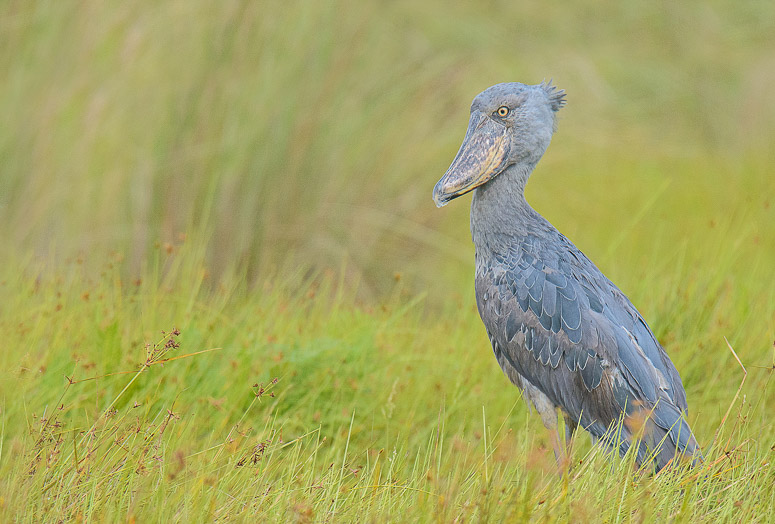
- 1800-BIRDING freecall

Tropical & Far North Queensland Birding Tour
Tour Spot Available
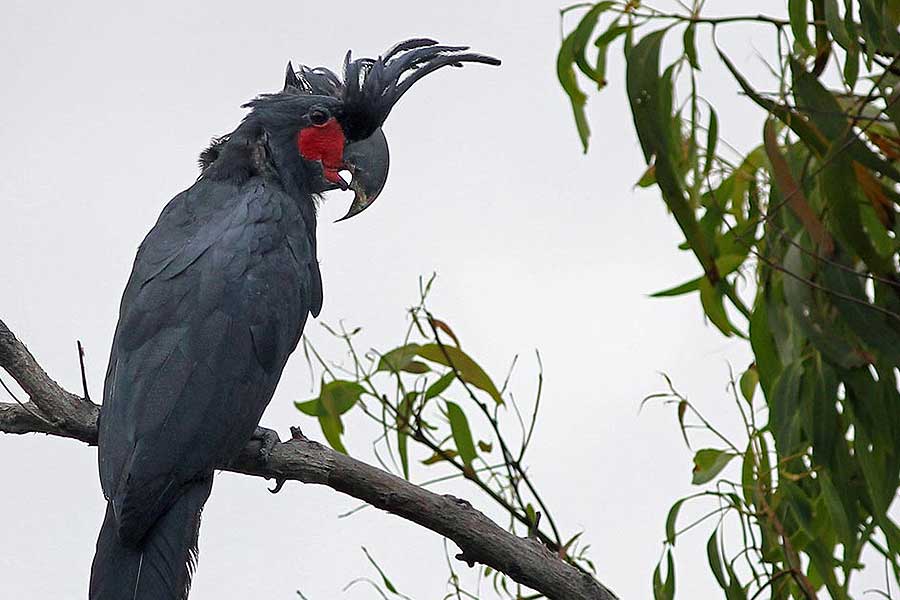
North Queensland Birding
Tropical & Far North Queensland (the area around Cairns and all the way up the Cape York Peninsula) is without doubt one of Australia’s top birding destinations. A variety of tropical habitats including rainforests, palm-fringed beaches, mangrove-lined mudflats, tropical savannahs and cool mountain ranges result in a bird diversity unparalleled elsewhere in the country. During this tour we start and finish in Cairns, where we aim to find all local specialties including the 13 endemic birds of the Cairns region, plus many other great rainforest, woodland, wetland and grasslands inhabitants.
Birdwatching in North Queensland
We’ll look for birds such as the sought-after Cassowary , the beautiful Golden Bowerbird and the rare Blue-faced Parrot-finch, Double-eyed Fig-parrot, Lovely Fairy-wren, Tooth-billed Bowerbird, Bridled Honeyeater, Yellow-breasted Boatbill, Spectacled and Black-faced Monarch, Spotted Catbird, Victoria’s Riflebird, Mountain Thornbill, Pale Yellow and Grey-headed Robin, Papuan Frogmouth, Sooty Owl and many more. We’ll also look for mammals such as Bandicoot, Sugar Glider, Northern Striped Possum, Red-necked Wallaby and Tree Kangaroo. The tour traverses the unique Cape York Peninsula where we aim to find all Far North Queensland specialties. Expect up to 200 species including all the important birds this area is well-known for such as Magnificent Riflebird, Frill-necked Monarch, White-streaked Honeyeater, nesting Red Goshawk , Palm Cockatoo , Eclectus Parrot , Yellow-bellied Kingfisher and more. We’ll stay a couple of nights at a well-known birding lodge; we’ll visit the Cairns coastal area; the Daintree Rainforest and Daintree River; we’ll have rare access to Golden-shouldered Parrot nesting sites; explore Rinyirru – Lakefield National Park; we’ll go night spotting for owls and mammals; and we’ll spend three days in Kutini Payamu – Iron Range National Park, one of Australia’s most important ecosystems. At the end of the trip, you can expect well over 200 species including all the important birds this area is well-known for!
Featured Birds
- Southern Cassowary
- Golden, Tooth-billed Bowerbird
- Grey-headed Robin, Noisy Pitta
- Squatter Pigeon, Great-billed Heron
- Double-eyed Fig-parrot
- Blue-faced Parrot-finch
- Lesser Sooty Owl, Papuan Frogmouth
- White-eared, Pied Monarch
- Spectacled, Black-faced Monarch
- MacLeay’s, Yellow Honeyeater
- Black Noddy, Black-naped Tern
- Red Goshawk, Eclectus Parrot
- Golden-shouldered Parrot
- Mangrove Robin, Frill-necked Monarch
- Fawn-breasted Bowerbird, Palm Cockatoo
- Northern Scrubrobin, Marbled Frogmouth
- Trumpet Manucode, White-faced Robin
- Little & Yellow-billed Kingfisher
- and many more.
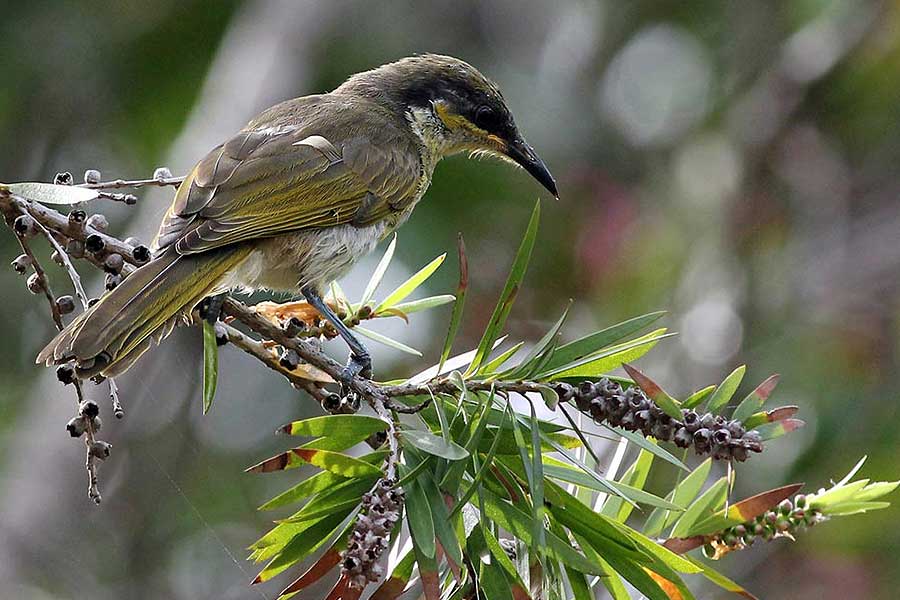

Welcome to Scilly Pelagics: pelagic trips operating out of St. Mary’s, Isles of Scilly. You'll find information about our pelagic trips and our studies of seabirds observed off Scilly and across the world. You can book pelagics and purchase our multimedia guides and clothing.
Scilly Pelagics is managed by Bob Flood and Joe Pender. We provide expert knowledge about seabirds, seabirding, seamanship and where to find seabirds and ocean wildlife in Scillonian waters. We offer an unsurpassable service in the British Isles for pelagic birding. Scheduled trips and private charters are available.
In partnership with

July/August 2024 Birder Special Pelagics
What we offer....

Birder Special Pelagics
Scilly Pelagics was launched in 2006 to cater for the ever-growing interest in seabirds and other wildlife regularly found in Scillonian waters. Scilly Birder Special Pelagics are a long weekend – Friday to Monday inclusive – to see and photograph as many specialities as possible, in particular Cory's and Great Shearwaters and Wilson's Storm-petrel.

Sapphire Pelagics
Operated by experienced seaman and skipper of MV Sapphire Joe Pender, Sapphire Pelagics offers short-range pelagic trips combining seabirding with a shark-tagging programme. A team of experienced local birders and shark taggers will be on board to help with spotting, identification and distributing chum, the key ingredient to attracting sharks and seabirds.

Multimedia ID Guides
Multimedia Identification Guides to North Atlantic Seabirds is a unique series of books and DVDs covering the detailed identification of all Procellariiformes occurring in the North Atlantic. The series includes Storm-petrels & Bulwer's Petrel; Pterodroma Petrels; Albatrosses & Fulmarine Petrels; and Shearwaters. This groundbreaking collection is a vital addition to any seabirder's library.
Our new range of quality embroidered Scilly Pelagics clothing includes
caps, polos, and hoodies all available in grey and navy blue.
Polos (men's and women's) and hoodies available in various sizes.
Scilly Pelagics clothing range

Pelagic Customer Reviews
Quotes from twitter....
Just had the absolute best day, watching common dolphin bow-riding during the Scilly Pelagic. Also, the 19+ Wilson’s Storm-petrels were OK! SB
@scillypelagics thank you so much for the last two days. Great birding. Trips so well organised and call-outs and directions are superb. Great fun, tremendous views. Anyone reading this, go do it! BU
Superlative seabirding today with @scillypelagics. BD
Just the best of birding experiences. Wilson’s Storm-petrel, Great Shearwater, Cory’s Shearwater …just some of the highlights of the Scilly Pelagics weekend, enjoyed with my son. Brilliant @scillypelagics. ST
A fantastic 3 days with so many highlights. Thx for an unforgettable experience. SC
One of the best, if not the best birding trips I’ve been on. RK
You could nearly touch the shearwaters. Absolutely fantastic. Can’t wait for next year. GM
Had a brilliant day on Sunday. Life-ticked Wilson’s. Huge numbers of Great Shears, loads of Cory’s, all point-blank views. Thanks guys. MB
Trip of a lifetime. BP
Genuinely the best birding experience of my life! Thank you so much. AT
Absolutely fabulous four days with Scilly Pelagics. Memories are made from trips like that. RH
My 1st trips with @scillypelagics for ca 10 years were excellent – e.g. on Saturday we spent ˃20 mins surrounded by Wilson’s Petrels. NW
Our trip was simply joy. GE Genuinely one of the best birding trips I’ve been on for a while, @scillypelagics were fantastic. SF
Isles of Scilly, United Kingdom

- Trip Leaders
- Winter Trips
- Gulf Stream Trips
- Registration
- Essential Info
- Subscribe for Updates!
- (252) 473-9163
- cahow1101@gmail.com
- P.O. Box 772 Hatteras, NC 27943
Excellence in Pelagic Birding
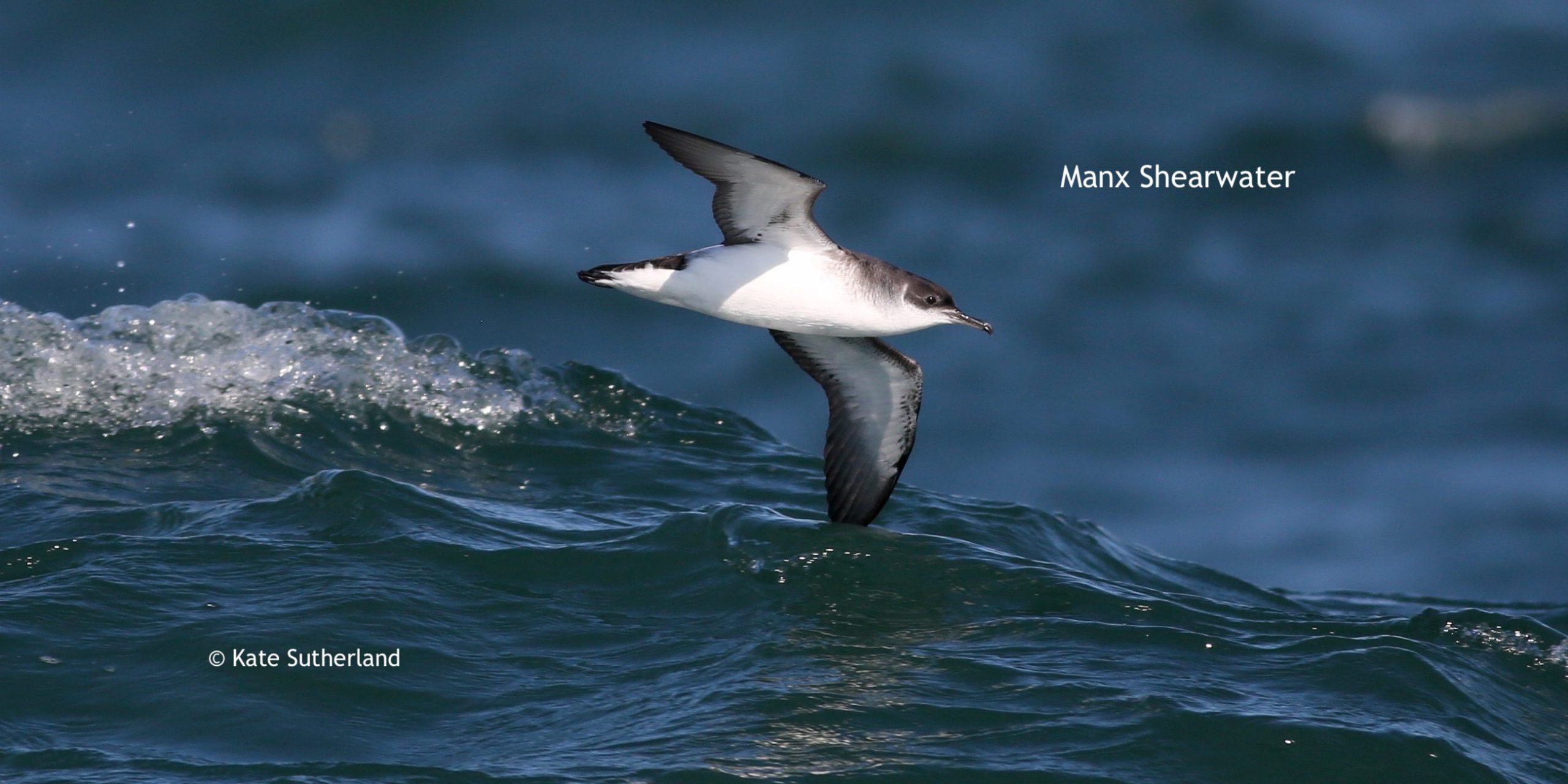

- Bylaws and Articles of Incorporation
- Statement on Equity, Diversity and Inclusion
- Window Collisions and Birds
- How to release a bird from a fishhook
- How to attract birds
- Bird Identification
- Bird of the Month
- Palm Beach County Birding Sites
- Palm Beach County Checklist of Birds
- Photography Group
- Field Trip Locations
- Field Trip Liability Release Forms
- Speaker Programs
- Conservation Stewardship Training Course
- Eagle Watch
- Friends of Audubon Everglades Membership
- Donate to Audubon Everglades
- Amazon Smile
- Conservation Alerts
- Kite Newsletters
- Annual Brochures
« All Events
Spring Pelagic Tour
May 25 @ 8:00 am - 4:30 pm.
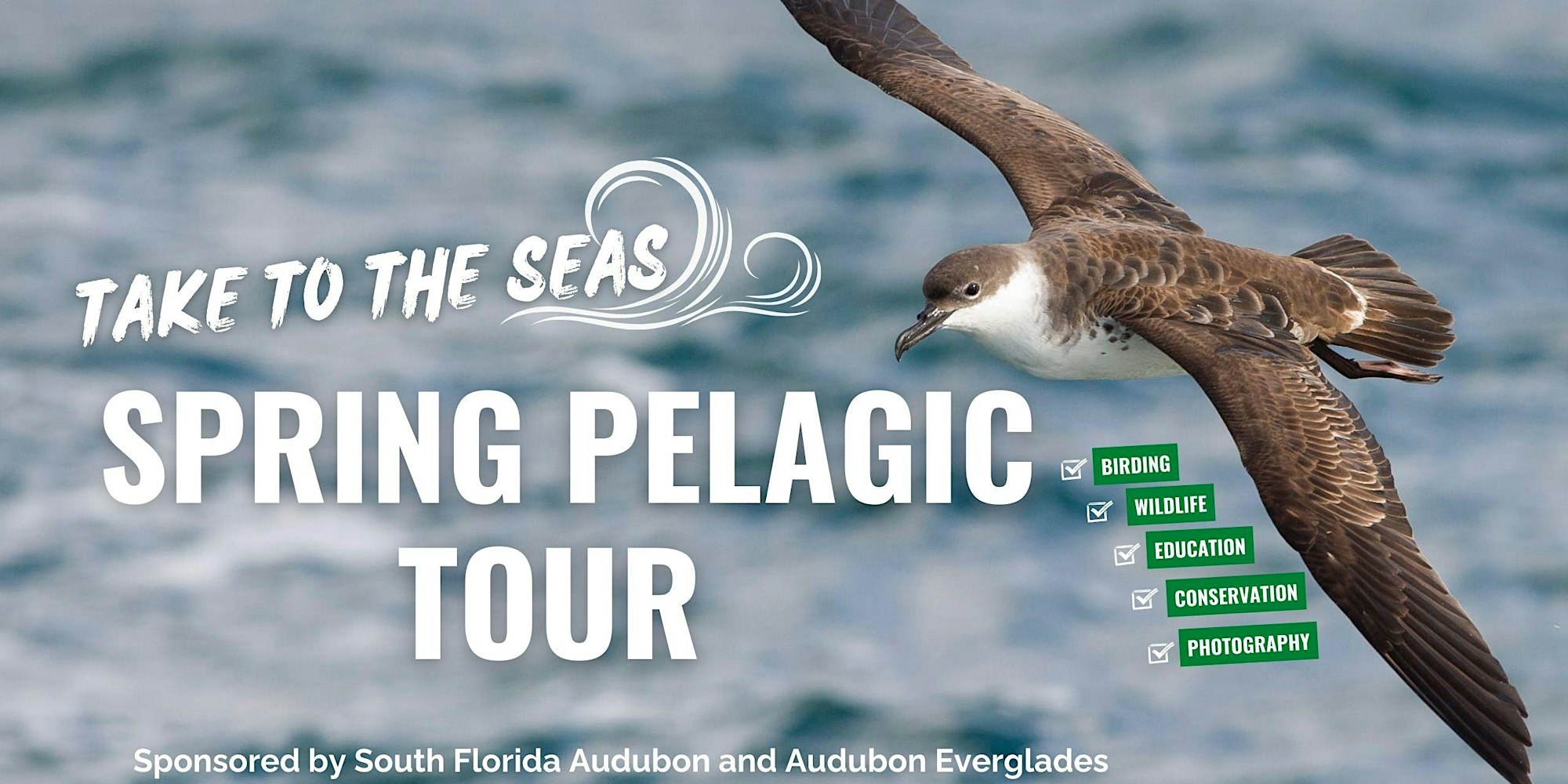
Embark on a pelagic birding expedition, where we travel by boat offshore to observe seabirds that seldom venture ashore except for breeding. Seabird species encountered during these pelagic journeys can include boobies, tropical terns, shearwaters, jaegers, gannets, and more. Join us for an fun all-day charter off the shores of Miami, led by experienced guides David Simpson and Beto Matheus.
Event Details: Duration: 8-hour charter Limited Availability: Priority registration for up to 40 individuals who are current members of Audubon Everglades and South Florida Audubon. No children under the age of seven, please.
Fee: $135 exclusively for members until March 4, 2024, then open to the public with a price increase to $160.
Fee includes boat trip, gratuity for boat crew and guides, snacks, beverages, and entertainment. Remarkable value compared to other pelagic trips!
Cancellation Policy: Full refunds available for cancellations before 5/15; non-refundable thereafter. Exceptions for emergencies or cancellations by charter-boat operators due to weather and/or sea conditions.
Time: Boarding starts at 8:15 am; departure at 8:30 am sharp; return to the dock around 16:30 pm. Punctuality is crucial, as the boat won’t wait, and there is no refund for missed departures.
Vessel: Departure from Bill Bird Marina in Haulover Park on The Mucho K, a 65ft. fishing vessel with an open lower deck and a partial upper lookout on the bridge. The Kelly Fishing Charter Company is our host with Captan Jamie at the helm. it has comfortable seating, clean restrooms, and USCG approval for 48 passengers. Limited to 40 participants for an optimal seabirding experience.
Route: Journey through Haulover Inlet to the west wall of the Gulf Stream to spot tropicbirds, terns, shearwaters, jaegers, gannets, storm-petrels, scoters, alcids, and more. Possible stops for wildlife sightings along the way.
Weather: Captain’s decision to cancel in case of rough conditions. Announcement may be made up to 30 minutes before boarding. If canceled, rescheduled date is June 2, 2024 , automatic registration for the alternate trip. Contact Paula or David if unable to attend the backup date.
Ebird: An ebird list will be created for the trip. If someone has registered you and you’d like to be part of the shared ebird list, kindly provide your email address to [email protected] .
For inquiries or assistance, please contact: Paula Gatrell: [email protected] David Lagan: [email protected]
Wishing you an enjoyable time and good luck in spotting those magnificent Pelagics!

Meet our Field Guides and Spotters :
David Simpson has lived a lifetime working and playing in the wilds of Florida. Working full time for the Florida Park Service for several years, running two Florida Big Years and countless Big Days, and extensive county listing, as well as several environmental consulting jobs have led to an extensive knowledge of Florida’s amazing biodiversity. These days, he continues to work on environmental consulting jobs as well as speaking, leading trips at festivals, and conducting private guided tours where he will share this knowledge with anyone who will listen.

Luis “Beto” Matheus has always been interested in nature and wildlife. Even as a kid growing up in Venezuela, he always kept a copy of “A Guide to the Birds of Venezuela” by Rodolphe Meyer de Schauensee and William H. Phelps (1978), the first bird field guide for any Latin American country, within reach. Yet he only became a “serious birder” around 2006 when he joined his father on a birding trip with Venezuela’s Audubon Conservation Society to Yacambú National Park, at the northernmost edge of the eastern Andes. After seeing a male Golden-winged Manakin (Masius chrysopterus) take off in front of him in the cloud forest, he went home, bought a pair of binoculars and was hopelessly hooked.he turned into a fully-fledged bird nerd. Beto has been actively birding ever since, often with his birding parents, serving as a voluntary eBird reviewer for Venezuela since 2008 and joining several Audubon chapters as he moves around for work. A civil engineer working in renewable energy development, Beto has lived in Mexico (Mexico City and Pachuca), Colorado (Boulder) and, now Florida (Boca Raton) with his wife and two teenage kids.

Directions:
Address: Bill Bird Marina, 10800 Collins Ave, Miami Beach, FL 33154
For those traveling from Palm Beach area, please allow ample time for driving, it is a highly congested area. It is approximately 1.5 hours from the West Palm Beach area. The GPS location can take you to a blocked entrance. If traveling from the North, continue South about 1/2 mile and look for the Haulover Marina sign.
As you enter the parking lot, head to the line of boats and turn to the LEFT.
There is ample free parking.
The Kelly Fishing Charter Company is a blue building. There are restrooms located at the end of the parking lot in a beige building. There are also heads on the boat.
https://www.google.com/maps/dir/25.9066347,-80.1241048/10800+Collins+Ave,+Miami+Beach,+FL+33154/@25.9043623,-80.1254628,16.5z/data=!4m8!4m7!1m0!1m5!1m1!1s0x88d9ad14d95bee87:0xbe9999372c54999b!2m2!1d-80.1244298!2d25.9065884?entry=ttu
WHAT TO BRING
Kindly pack your own lunch, as there won’t be any food available for purchase on the boat. We’ll supply snacks and drinks. If you have specific dietary requirements or allergies, we recommend bringing your own provisions.
It is usually breezy on the water. Dress a little warmer or wear layers. It is better to be layered with clothes that you can remove than to be cold and not have a jacket or sweatshirt to ease a chill. It can also get wet.
Wear close-toed shoes with a good rubber deck-gripping sole to prevent slipping or sliding as the boat deck is normally wet.
Bring sunscreen or a large hat as you will be on the water for eight hours.
This boat will venture 10 miles out to sea, we recommend that you take appropriate measures if you’re prone to seasickness. If prone to seasickness, look into over the counter medications, and choose the nondrowsy varieties ( Bonine). The main prevention is to get lots of rest the night before! Also avoid alcohol and spicy food prior to trip. Eat something bland for breakfast (i.e. toast) so your stomach is not totally empty; keeping something in your stomach goes a long way to minimizing the effects of seasickness. Consider ginger products. We will provide Ginger Ale, water, ginger candy, and also pretzels on board.
***eBird List: We will maintain a shared eBird list to document our sightings.***
WHAT NOT TO BRING Aerial drones Pets Spotting Scopes Tripods Weapons

- Google Calendar
- Outlook 365
- Outlook Live

COMMENTS
Commercial birding tours and information; Bird identification can be difficult, even for experienced birders, and many discussions occur during group walks and camps on this subject. ... Pelagic trips are almost the only way to see the true deep water birds such as Shearwaters and Petrels. ... Birds Queensland is the registered trading name of ...
Northern Royal Albatross. Some of the most popular pelagic trips head out to sea off Eaglehawk Neck (Tasmania), Port MacDonnell (South Australia), Wollongong (New South Wales), Sydney (New South Wales), Southport (Queensland), and Port Fairy (Victoria). These trips often fill up early, and booking far in advance is definitely recommended.
Birding Tours Australia conducted their first pelagic seabird trip in 1999 from Newcastle NSW and over the next eight years we held forty seabirding trips from Swansea and Newcastle taking hundreds of local, interstate and international birders out to the shelf. From 2004 to 2012 we also ran pelagic trips from Eaglehawk, Tasmania.
These tours are run by the Sydney Pelagic Group Cooperative comprising four local birders who are keen to keep these pelagics operating, and will continue to run as long as the support of the local and overseas birding fraternity continues. ... Birdswing Birding & Wildlife Tours ... Address: P.O Box 597 Malanda, Queensland, 4885, Australia ...
Pelagic birding trips are usually conducted out of areas where nutrient-rich waters are found close to shore. Some of the more productive day trips are conducted in Australia, New Zealand, the west coast of the United States and the southern tip of South Africa. A longer expedition to Antarctica is definitely the ultimate pelagic trip, though ...
Our Australia's Outback Queensland birding tour features the remote Cape York Peninsula of Australia's far northeast, the Mount Isa region and the arid far southwest of Queensland in search of a host of specialities that we see on no other tour. Australia, the smallest continent or the largest island on earth, depending on how you like to ...
Pelagic reports, species list and month-by-month sightings (downloadable spreadsheet - updated January 14) from Southport, Qld are also available. Trip Dates for 2019 12 January 2019 16 February 2019 16 March 2019 20 April 2019 18 May 2019 15 June 2019 20 July 2019 17 August 2019 21 September 2019
And finally, our three nights in Sydney will allow us to explore the best birding sites in the surrounding area and to take a pelagic trip rich in albatrosses, petrels, and shearwaters. In 2024 and 2026 this tour can be taken in conjunction with our Australia: Victoria and Tasmania tour.
Bird Watching in North Queensland. Fine Feather Tours Birdwatching Safaris is owned and operated by Del and Pat Richards. Based, between Port Douglas and the Daintree River, and adjacent to the richest birding area in Australia. Well over half of Australia's species of bird have been recorded within a distance of 200 kilometres. Our tours, which operate daily, allow birdwatching in up to ...
This was the first record of the species for a Sunshine Coast pelagic and the bird was of the race cauta, a scarce visitor to south-east Queensland. Shy Albatross We began laying a berley trail on the edge of the continental shelf 32 nautical miles offshore in 350 metres (S26.3.1; E 153.43.4) at 9.55am.
Birding Australia: Eastern Australia - From the Outback to the Wet Tropics. This tour takes in Victoria, southern New South Wales, and southern and northern Queensland and connects with a huge number of exciting endemic species in a wide range of habitats. Some of the highlights on this tour include Southern Cassowary , Plains-wanderer , Shy ...
Costs and Pricing. Tour Price From : 7 Days $5800pp AUD (Twin Share) 8 Days $6500pp AUD (Twin Share) Enquire Now. Islands of the Northern Torres Strait - Boigu, Saibai and Dauan The three Queensland islands of Boigu, Dauan and Saibai lie close to the Trans Fly area of New Guinea and are Australia's two most northerly inhabited islands.
Number of Passengers: 21. Facilities: Proper toilet fitted. Accommodation: Additional to cost of tour. Port Fairy has plenty of accommodation. Check out accomondation websites or contact the local visitor information centre for more assistance on 1300 656 564 or 03 5568 2682. Meals: BYO Lunch.
Pelagics — Hillstar Nature. The Ultimate Pelagic! 3-19 December 2024 with Alvaro Jaramillo & George Armistead Explore a unique wilderness on a Cruise Down Under the Subantarctic Islands of New Zealand & Australia to seek most of the world's albatrosses, rare petrels, 7 species of penguins, and island endemics as well.
It is one of the prime ports for finding storm-petrels. Many rare birds have been found here in the last ten or so years. Trip length - 10 hours, leaving at 7 am. Monterey: A pelagic trip out of Monterey's Fisherman's Wharf is perhaps the classic California pelagic trip as at one point nearly all trips left from this port.
Parrots are sure to continually impress during this tour, this is Turquoise Parrot. Day 9. Birding near Melbourne and conclusion of the "Outback" part of the tour. We spend most of the day at Bunyip State Park, about 40 miles (60 kilometers) east of Melbourne, birding wet sclerophyll forest and swampy heathlands.
The tour traverses the unique Cape York Peninsula where we aim to find all Far North Queensland specialties. Expect up to 200 species including all the important birds this area is well-known for such as Magnificent Riflebird, Frill-necked Monarch, White-streaked Honeyeater, nesting Red Goshawk, Palm Cockatoo, Eclectus Parrot, Yellow-bellied ...
The Petrel Station is known as one of the world's best full-day pelagic seabird tours for its incredible diversity of stunning seabirds (with 65 seabird species seen to date). Based out of Tutukaka (in northern New Zealand), these pelagic birdwatching trips are any birder's dream, offering a unique, memorable birding experience.
Scilly Pelagics is managed by Bob Flood and Joe Pender. We provide expert knowledge about seabirds, seabirding, seamanship and where to find seabirds and ocean wildlife in Scillonian waters. We offer an unsurpassable service in the British Isles for pelagic birding. Scheduled trips and private charters are available.
During a pelagic offshore we are likely to add Kermadec Petrel, White-bellied Storm-Petrel and perhaps Providence Petrel. Birdquest has operated Australia tours to New South Wales and Queensland since 1985. Lord Howe Island-only Option: You may opt to take just the Lord Howe Island section as a stand-alone tour.
Feb. 18, 2024; Alcids Aplenty by Brian Patteson February 23, 2024. After a day of strong winds from the north on Saturday, I had high hopes for getting out on both Sunday and Monday, but it wasn't to be. Sunday was nice enough though, and we had good conditions for seeing alcids with slight seas and cloudy skies.
PELAGIC BIRD WATCHING TOUR. Embark on an exhilarating adventure with our Pelagic Bird Watching Tour, tailor-made for seasoned bird enthusiasts. Departing bright and early, this six-hour voyage takes you 25 km offshore to the breathtaking Clayoquot Canyon aboard our 30 ft Boston Whaler, the Big White, led by experienced guide John Forde.
Spring Pelagic Tour. May 25 @ 8:00 am - 4:30 pm ... Beto has been actively birding ever since, often with his birding parents, serving as a voluntary eBird reviewer for Venezuela since 2008 and joining several Audubon chapters as he moves around for work. A civil engineer working in renewable energy development, Beto has lived in Mexico (Mexico ...